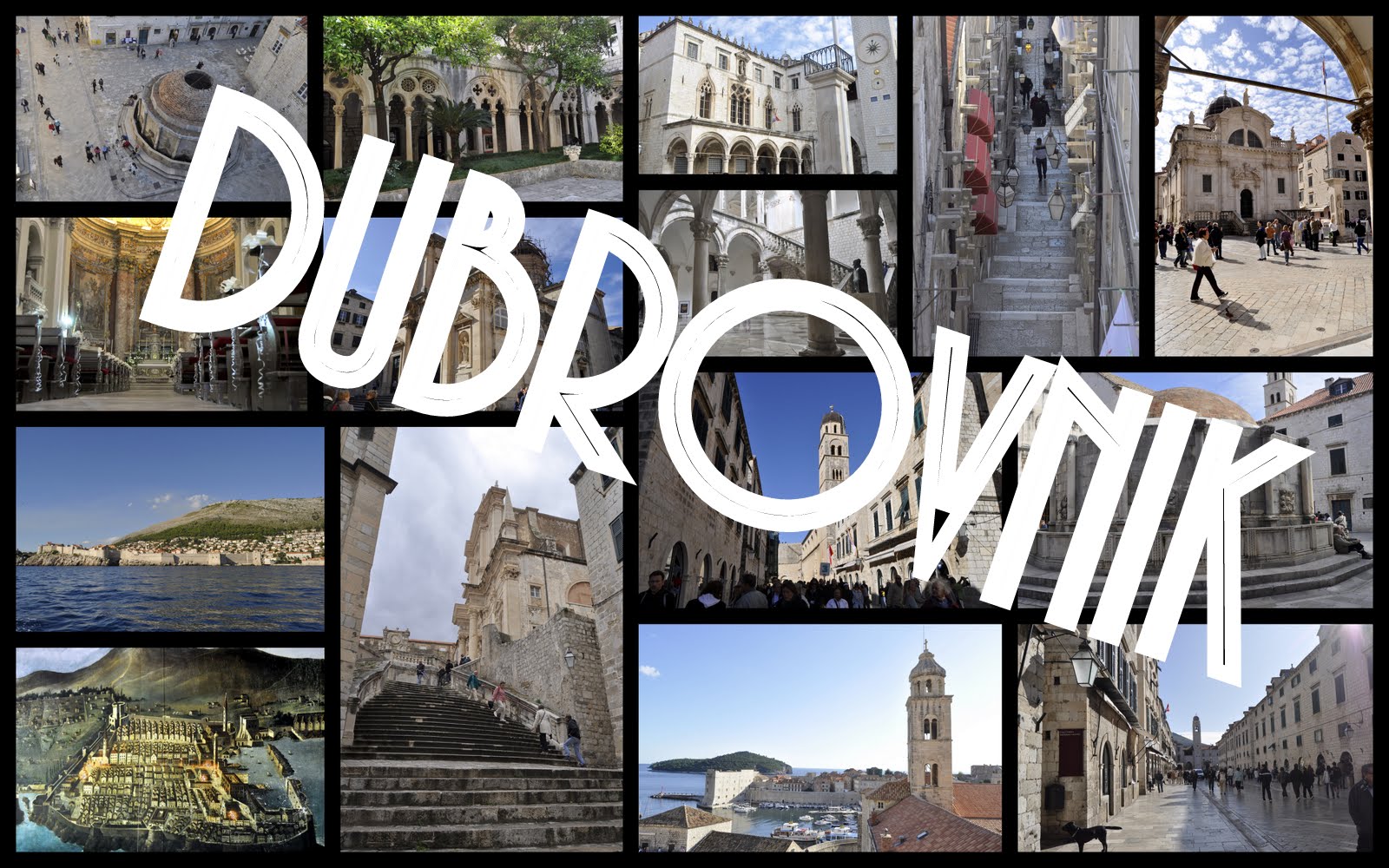
| You may prefer to see these pages as a photo slide show which contains the same text but presents the pictures full screen size. If so, click on the slides presentation at the right. |
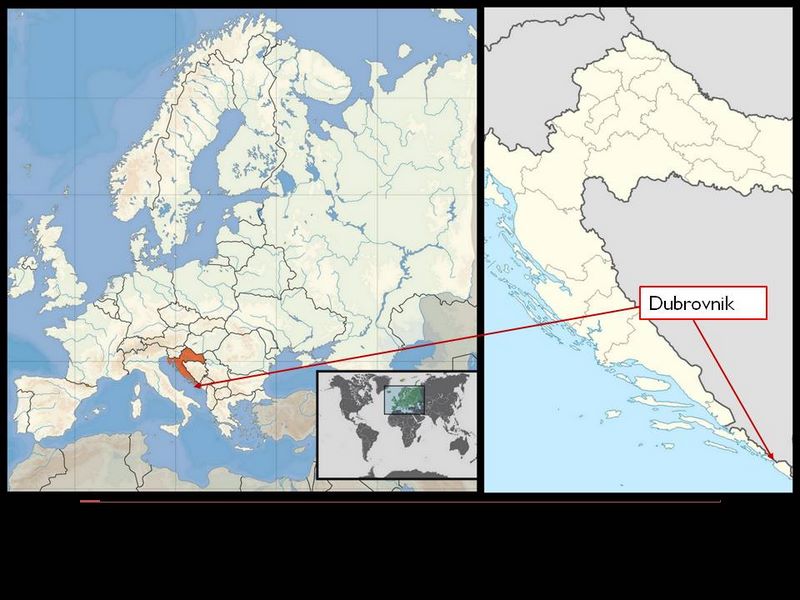
Dubrovnik is about as south as you can go and still be in Croatia. The country is very thin here, separated from the rest of Europe and Bosnia and Herzegovina by the Dinaric Alps which rise dramatically from the Adriatic.
Long a small but leading trading city-state of its own, Dubrovnik is sheltered from the ugly winds of the Adriatic by mountains and islands, giving it a pleasant Mediterranean climate (or so the tourist office says -- we experienced a lot of October rain here).
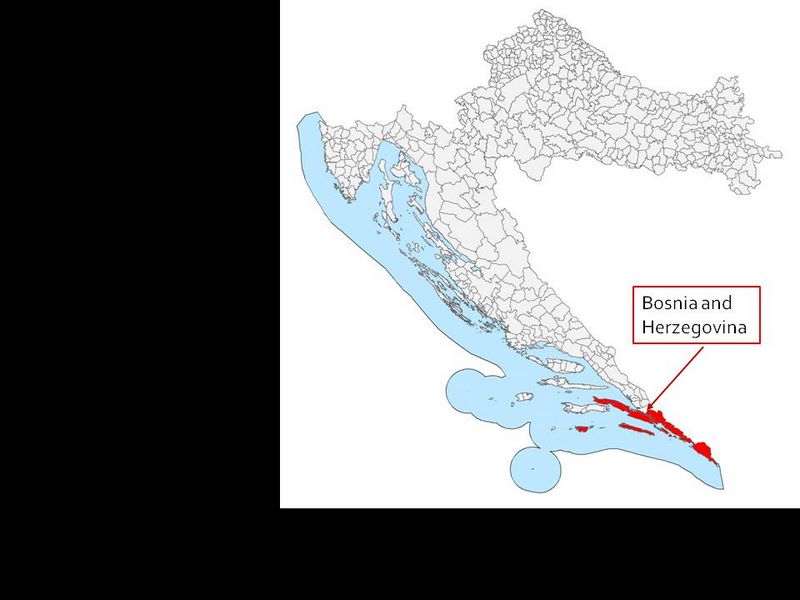
We landed in Dubrovnik after being told that we might have needed to divert to Split (many hours away) because of high winds. This was no idle threat, as the US Secretary of Commerce and his entourage had died in a crash while landing here. (OK, the Serbs had stolen a lot of the airport's navigation gear, but that's another story.)
The red on the map above shows the once independent republic of Ragusa (Dubrovnik) which ceded sea access to the Ottoman Bosnia province -- and cut Dubrovnik's area (shown in red) off by land from the Venetians encroaching down the Dalmatian coast. (The rest of Croatia is shown in gray.)
This tiny republic was pretty close to most Mediterranean trade routes -- and bullies. It stayed independent for four centuries by playing Slavs, Ottoman, and Venetians off against each other through skilled negotiation, tribute, and bribes.
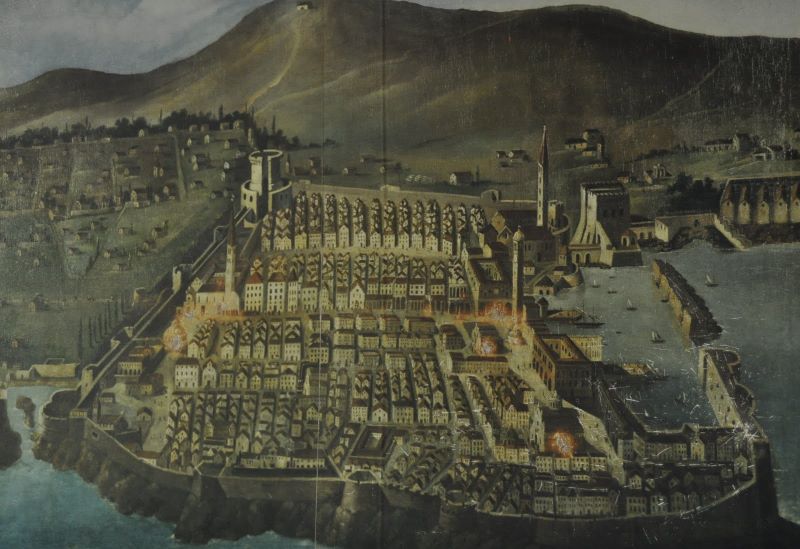
Dubrovnik has been through a lot but thanks to the tourist trade, the city makes sure it looks a lot like this old picture hanging in the Franciscan Monastery. Today we still visit a superbly restored walled town (although the harbor fortifications have been lowered at right.)
Cutting horizontally across the middle of this picture between two towers is a wide street ending at the port. Once what was above it was mainland and below was the island where the Romans sheltered their colony. In the 12th century, the marsh between was filled in, making it all one town.
That steep rise in back is Mount Srdj which protects Dubrovnik from the nasty north winds that Croatians call "the bura."
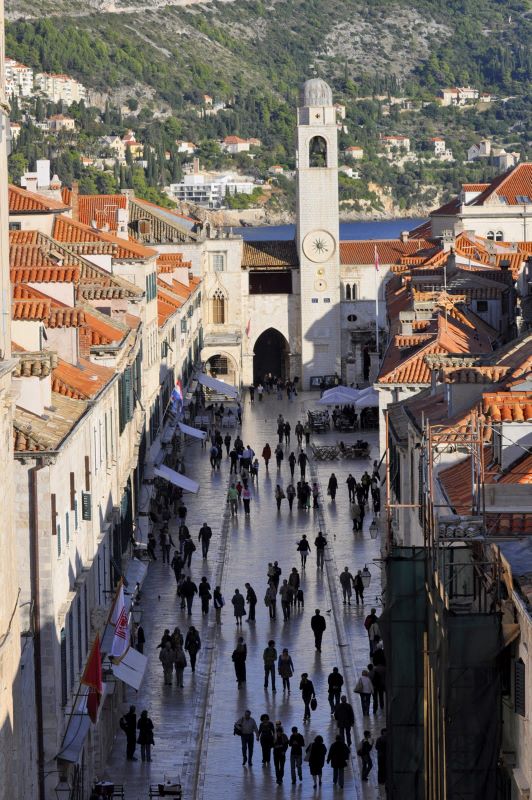
Here's that street today called Placa or Stradun. Once the left side was the end of a continent and the right was an island -- both with briskly descending coastlines like that green shore in the distance. As you would expect of what was once a watery channel, this 300-yard passage is level -- but the hilly town it bisects rises steeply on either side like a butterfly's wings. A series of civic monumental buildings start just in front of the clock tower in the distance.

Here's another view of what that butterfly's torso looks like: the main drag in Croatia's southernmost town. Dubrovnik is about as far north as Detroit, Michigan, but has a Mediterranean climate.
It was once the capital of the Republic of Dubrovnik (Ragusa in Italian), the smallest of the Maritime republics that also included Pisa, Genoa and Venice. As its own nation it took great pride in its independence and the rights of its citizens and had all sorts of checks and balances to keep a tyrant from seizing power. It was one of the first countries to recognize those 1776 upstarts who eventually became the disUnited States of America. United, it managed to be relatively free for four centuries by playing the major powers such as Venice and the Ottomans against each other. Will our republic last as long?
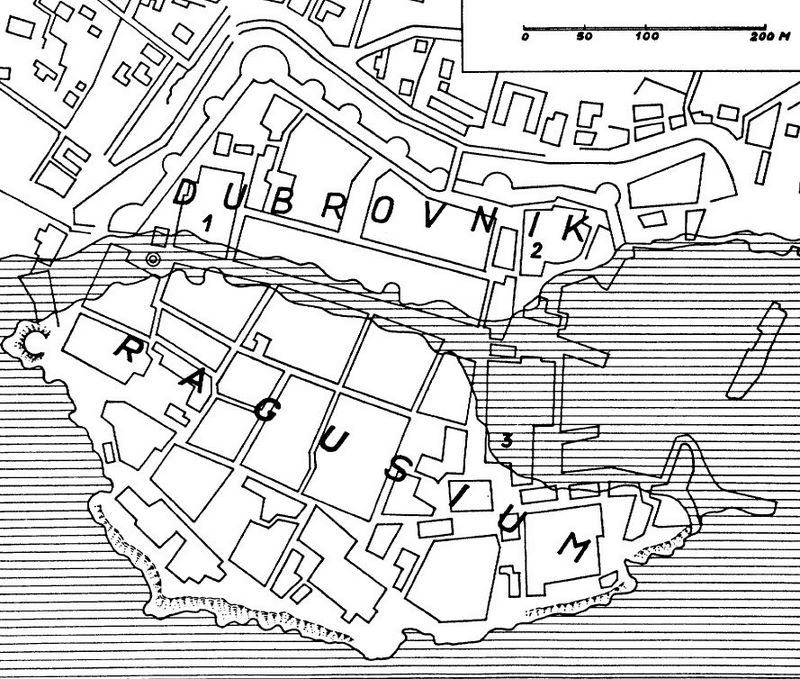
This map explains why a medieval city could sport such a wide street. It started as two towns: the Roman Ragusium (Ragusa) at bottom -- an island separated from the Slavic Dubrovnik. An extraordinary bit of 12th century civil engineering filled in the channel and left space for the long Placa (Stradun) and the wide expanse in front of the Rector's palace -- #3 on the above map. (Thanks to F. W. Carter for this map.)
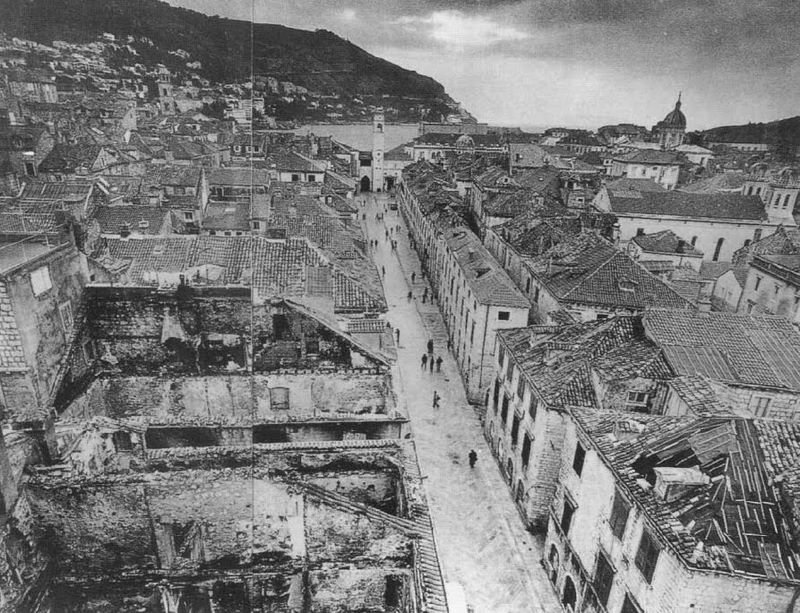
Here's a much darker view: Dubrovnik after the 1991 fall bombing. The Serbs in the Yugoslav army targeted cultural areas (of course, protected by the Hague convention) such as Dubrovnik. Until then, this town through skilled diplomacy had not known war in over a millennium despite living in the middle of its enemies (Venice, the Turks, etc.) Strategically, Dubrovnik had nothing to offer the Serbs and there were no Serbs here to liberate.
Rockets tore into the town's tourist hotels that sheltered mostly women-and-children refugees. All roads leading to Dubrovnik were cut off as well as sea and air access: 50,000 people had no water, electricity, or food supply. The West protested Europe's latest war, but did little else -- sending observers instead of warriors. Fourteen years later, the International Criminal Tribunal for the former Yugoslavia sentenced the general who gave the orders to 8 years in prison. (Photo: Romano Cagnoni, in Newsweek)

The town has that hilly, compressed feel of other former capitals such as Toledo, Spain. Here clockwise we see the old port at 9 o'clock; Lokrum island at 10 o'clock; and the Jesuit church at noon. The main drag Stradun points its diagonal at the old port. This island of Lokrum was once the home supposedly of Richard the Lionhearted after a 1192 shipwreck on the way home from the crusades. After Napoleon came by, it housed Archduke Maximilian who had that unfortunate misunderstanding with the Mexicans shortly thereafter. Today it's the home of a Botanical Garden and (like some Croatian islands) a nudist beach. Nothing like wild life.
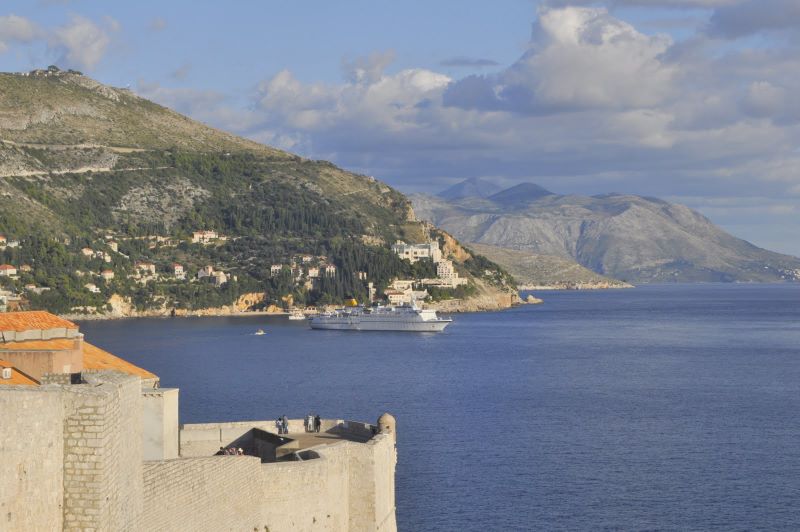
Tourism is the main driver for the economy today as cruise ships such as this disgorge their throngs during the season. (In 2008, cruise ships stopped over 700 times -- jamming crowds into a walled town of 1500 inhabitants!) The Dinaric Alps here plunge into clear sea giving this a beautiful -- but not necessarily sandy beached -- coastline.
While winds in this part of the world can be rough, Dubrovnik is insulated from the rain-soaked southern wind (called the jugo) by the island of Lokrum, and from the cold norther (called the bura) by mount Srdj.
Before tourism, Dubrovnik's wealth depended upon trade. Nobles controlled most of the land, all of the political power -- but not all of the wealth which could be earned through shipbuilding and shrewd trading. The common people had good jobs, individual rights, and prosperity. Civic unrest was pretty much unheard of.

Once mainland and island were connected, walls rose. Dubrovnik's walls are highly visible as one approaches the city, day or night, from land or by sea. One of the strongest set of fortifications in Europe, these were never breached.
The town was conquered only once, when that rascal Napoleon and his buddies were invited in to help protect the place -- and then decided to stay. Despite these formidable walls, to a large degree, Dubrovnik's best defense were the skillful diplomats who played the city-states's enemies off against each other such as the Venetians and the Turks. (Diplomacy sometimes consisted of paying tribute -- and bribes -- to each of those countries as well.)
At the rear we see the Croatian coast rising up Mount Srdj. Croatia is only about 4 miles wide at this point. Over the mountain lies Bosnia and Herzegovina -- land of the Ottoman's until 1878.
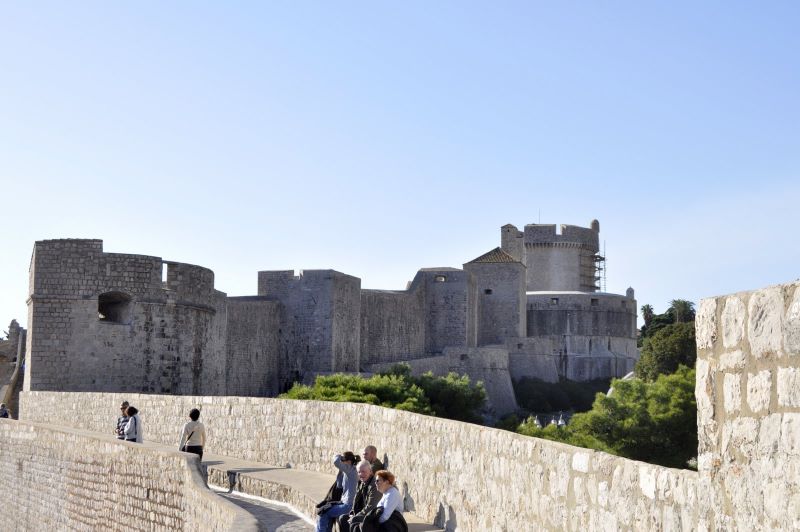
These walls were a long time abuilding and today are superbly maintained. They make for a pleasant walk of just over a mile. These replaced previous defenses and were built and rebuilt from the 11th to the 14th centuries as the city expanded.
The Turk threat starting in the 15th century gave Dubrovnik, like much of southern Europe, a strong incentive to further fortify its defenses, especially on the land side. Work continued into the second half of the 17th century.The Russian fleet besieged the city for a month in 1806, sending over 3000 cannonballs against these walls. Using its usually trick of encouraging its enemies into destroying each other, Dubrovnik agreed to give the French safe passage to fight the Russians. They fought -- but stayed. Thus ended four centuries of this mercantile republic's independence.
The stone path here rises to the highest defense, the MinÄeta Tower. Below it is a separate scarp wall designed to take the hit of an artillery attack while keeping the tower defenses intact.
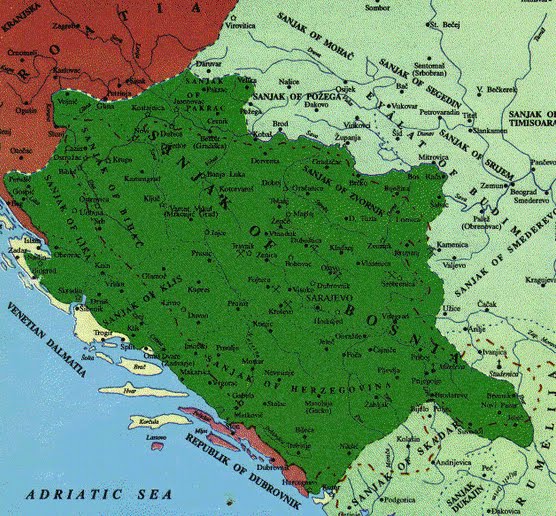
These walls had to be good as Dubrovnik is still here. Above, the dark green blob was for four centuries the Ottoman's westernmost province: Bosnia, which hovered just over the Dinaric Alps threatening the skinny republic of Dubrovnik shown in magenta. Pale green Venice encroached with its string of islands and shoreline colonies, creeping like a snake along the northeast shore of the Adriatic. For citizens of tiny Dubrovnik, good fences, and diplomacy, made good neighbors. (Thanks to the University of Texas for putting this map into the public domain.)

Above is what a bit of that green blob looks like at ground level where it's the 12-mile border between Croatia and Bosnia and Herzegovina. (See the magenta arrow on the CIA's map at right). We stopped and got our passports stamped. (When Croatia joins the European Union, this will be a hassle.)
This is the land Dubrovnik gave to the Ottomans so that the Venetians could not move its army by land without entering Ottoman territory. For centuries it served as the best part of the walls of Dubrovnik. But not as scenic...
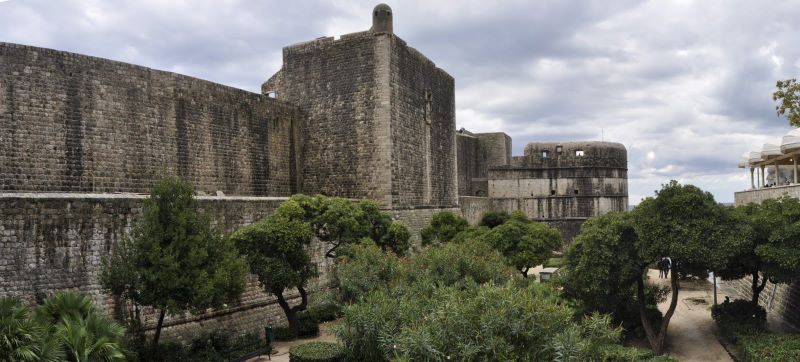
...as this work by renaissance architects. Here's an example of the land-side walls looking southwest from the main gate towards the Bokar fort as these thick walls hover over their moat (now a garden.) The land walls are typically 12-19 feet thick -- and strong enough to survive the 1667 earthquake that devastated most of Dubrovnik.
At center we see a square tower -- 1 of 15 built during the 14th century. The lower portion is the scarp wall. At right is one of two cylindrical towers built by the famous Florentine architect Michelozzo. These walls held even during the 2 month onslaught of the modern Yugoslav army in 1991.
Modern military theory holds that artillery made castle walls irrelevant long ago -- but Dubrovnik stayed as impregnable as it has since these walls were built. (It helped that the Serbs really didn't know how to use their attack hardware all that well).
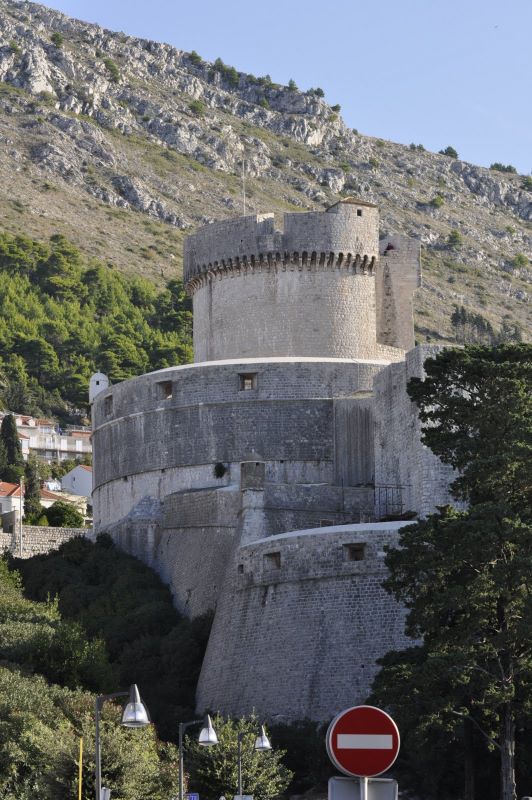
Here's an outside view of the stone wedding cake known as the MinÄeta tower -- the work of two architects more famous as sculptors, one Renaissance and the other Gothic.
The middle section was done by Michelozzo di Bartolomeo Michelozzi, builder for the Medicis. As a sculptor and collaborator with Donatello, Michelozzo did subtlety. But as a defensive architect, he did force as well. Here he added 20-foot walls atop the existing 4-sided fort.
After Michelozzo, work continued by a Venice-trained sculptor/architect from the Croatian city of Zadar named Juraj Dalmatinac (or in Italian, Giorgio da Sebenico.) Dalmatinac was not quite the Renaissance man like the Michelozzo. He's best known as a medieval sculptor and his masterpiece is the Gothic cathedral (and UNESCO World Heritage site) in his home town of Å ibenik.
Construction on this tower completed in 1464 -- since then it has been a symbol of the impregnability of Dubrovnik.
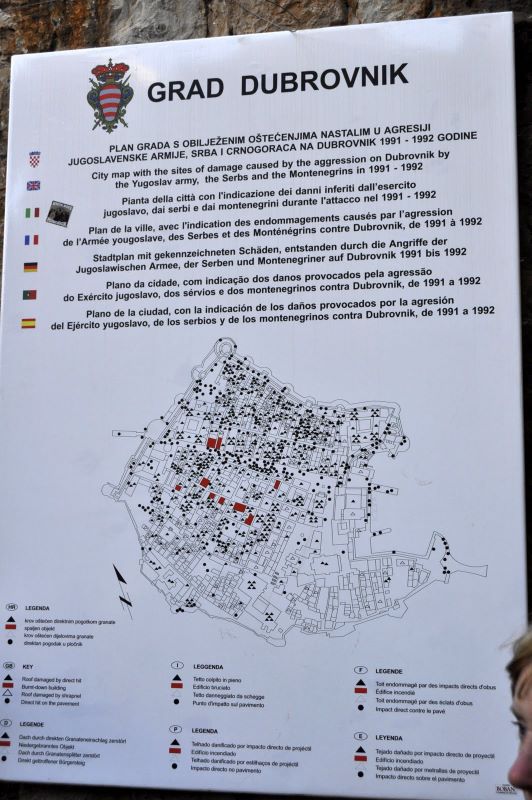
Just inside the main gate, Dubrovnik reminds its many visitors of the devastation caused by the 1991 assault by the Yugoslav army as they attempted to capture Dubrovnik from Croatia and give it to Montenegro. Over 650,000 shells hit the area with more than 1,000 landing inside the city walls where over 250 people died. The marks show where shells hit in this UNESCO World Heritage site with no military targets. (Over 2/3rds of the buildings took a hit.)
Dubrovnik's location far from the major portion of Croatian territory made it difficult for her defenders to obtain assistance from their countrymen. Serb attackers shelled the city from the mountains above and the sea around it after cutting off food and electricity. Water was rationed inside at 1.2 gallons per day. (If you have an efficient American toilet, you use 1.6 gallons per flush).
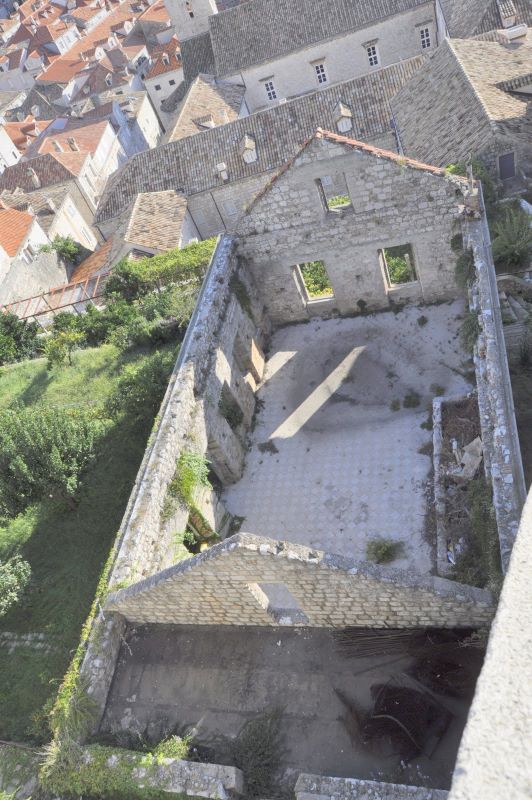
Most of the buildings were rebuilt -- new roofs show up with a slightly different color of tile than those lucky enough to have been in place for centuries. A few still raise roofless walls to the sky in protest against the 1991 siege.
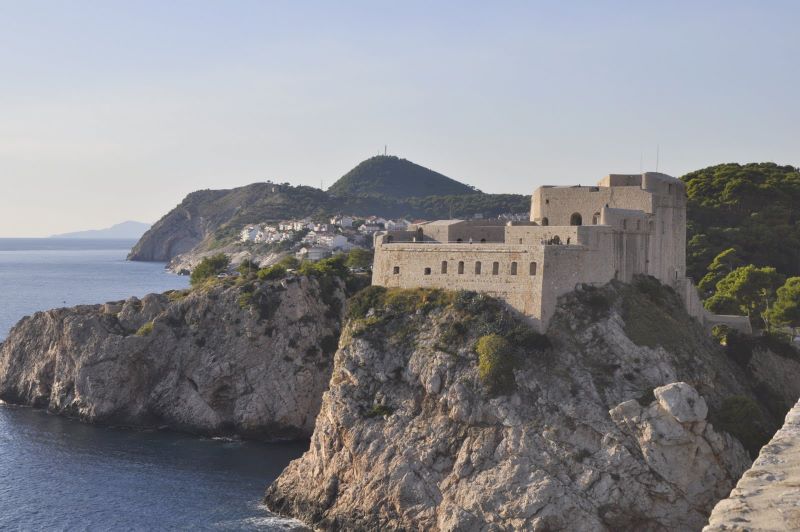
Built triangular in shape to fit its rocky underpinning, Fort Lawrence (Lovrjenac) is known as Dubrovnik's Gibraltar. The rock base is not level -- creating the need for the three terraces we see here. (Today these terraces make a great backdrop for the Summer Festival's staging of "Hamlet" as Danish ghosts walk these walls.) The sea-side walls are very thick -- nearly 40 feet thick -- to resist the enemy cannons. By contrast, the walls facing the city are thin and easily breached. The reason for this is that Dubrovnik wanted to ensure that the fort commander would not use his position to seize control of the city he was sworn to protect.

The other end of town is protected by St. John's fortress (from which this picture was taken) and the Revelin Fortress shown in mid picture jutting out like the prow of a battleship. Revelin was built in the 16th century as the Ottoman Turk danger grew. For 11 years no other construction was allowed so that all resources could be focused on fortifying this point with all deliberate speed. A chain would be suspended between these forts to the breakwater (called "Kaise") at right to keep out enemy ships during time of siege.

This long building on the shoreline just south of the walled city was built as the lazaretto, or quarantine. Those towns like Dubrovnik which made their living by the sea trade were at ground zero for the spread of infections. This risk was somewhat lessened by placing new arrivals into separate buildings (even islands) for forty days (and Dubrovnik gave us the term "quarantine" derived from the Venetian-Italian dialect word for "forty.") This building was created and modified from the 16th to 18th centuries, but its predecessors date from the 14th century when the Black Plague eliminated nearly a third of Europe's population. Six long buildings and courtyards rise perpendicular to their connecting sea wall in one of the few quarantines left in Europe.
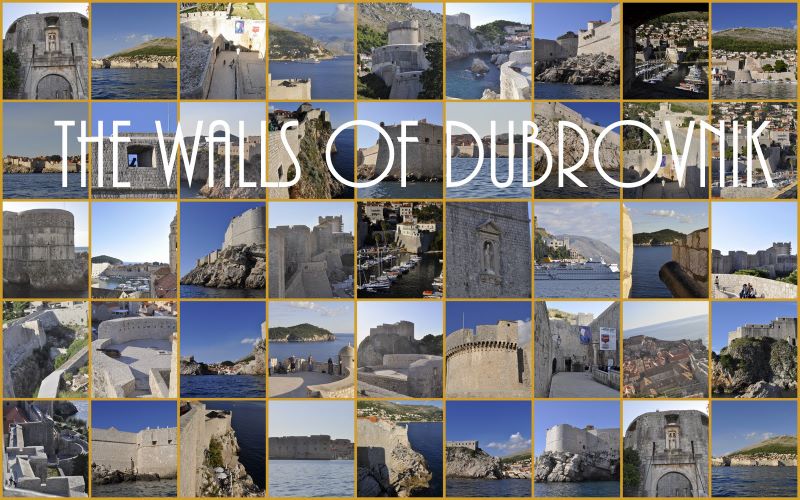
We've got about 2000 more words of text and lots more pictures of Dubrovnik's walls. See them by clicking here.
Let's now step inside the walls using the west entrance (the Pile Gate) as do nearly all of the tourists.

A hexadecagon inside a square! Just inside the western (Pile) gate, we encounter the Paskoja Milicevica Square surrounded primarily by religious buildings. It's famous for its 15th century fountain built by Dubrovnik's master plumber: Onofrio de la Cava from Naples. Despite having its top story removed by the 1667 earthquake, this reservoir stored water brought by aqueduct from the Dubrovnik River for over 550 years -- until the Serbs bombed it in 1991. The Placa (Stradun) street starts here where the marshy channel was filled at the end of the 11th century connecting the Roman island-colony at right with the Slavic mainland at left.
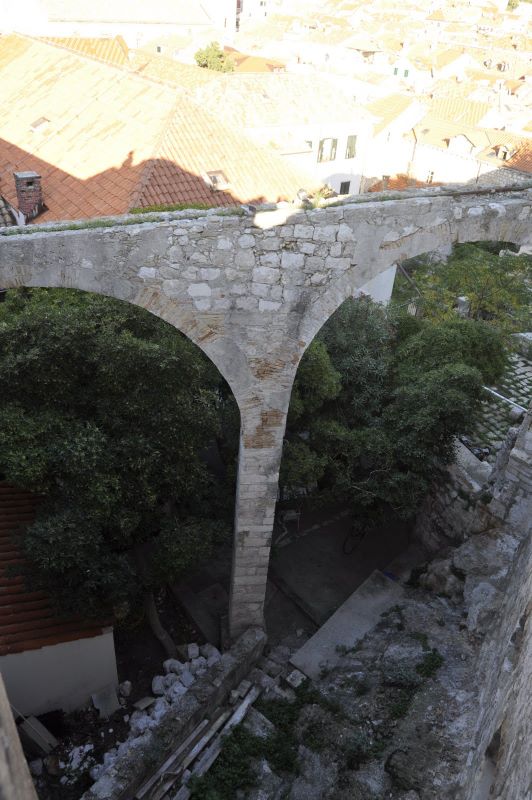
Most towns in the region gathered rainwater in cisterns below their squares. Not so here as Onofrio brought water from the Trebišnjica River seven miles to the northwest using aqueducts such as this one visible inside the city and most likely feeding the uphill Jesuit square.
Onofrio's feeder split outside the city in order to provide the Pile area workshops to the west with water. This one entered the city at its highest and northernmost point where the Minceta tower would eventually rise.

Onofrio's aqueduct fed several fountains that he built in the city around 1440 including separate ones for the Jesuit and Jewish quarters as well as for the fish market. This is his largest, creatively called the Big Onofrio Fountain. (Size mattered as it was also the town reservoir so we'd expect it to be about the size of a water tower in an American small town.) It was even bigger until the 1667 earthquake knocked off its second story. Water fills the basin that surrounds this domed structure through spouts at the center of the decorated emblems...
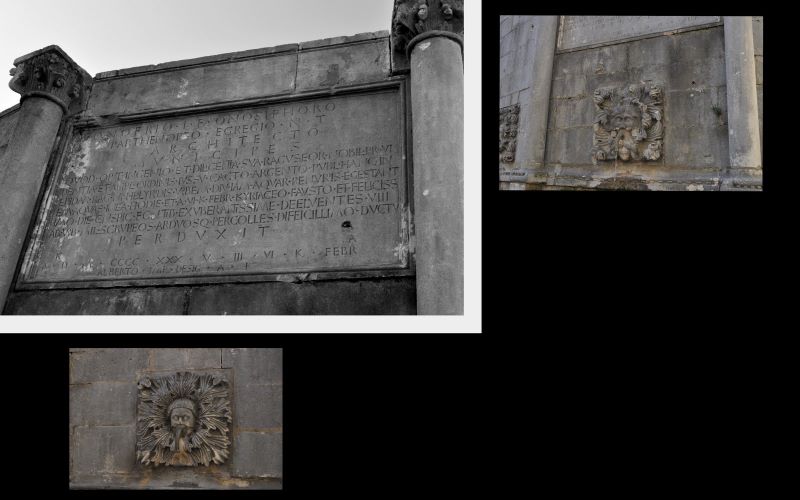
Each of the 16 sides has an elaborate carved medallion with a water spigot at center feeding a horse-trough below. The ravages of earthquake and war have made many of these candidates for restoration. At top left, a plaque spans the header between two Corinthian pillars.
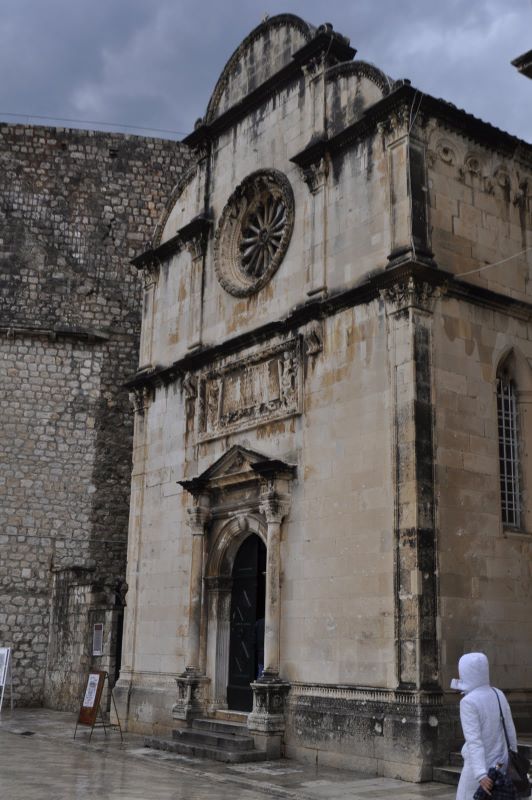
Across from the larger Onofrio fountain rises the Renaissance facade of the Church of the Savior. The Dubrovnik Senate commissioned this 1528 building in thanksgiving for the city surviving the 1520 earthquake. Its 3-leaf semi-circular cap bears a strong resemblance to several churches in this region as this was oft-imitated (and itself imitated a more elaborate facade of St. Zaccaria's in Venice.) It does earthquakes well as it is about the only building to survive the 1667 earthquake pretty much intact.

As my Nikon licked the glass in the church's locked door, it captured this curious mixture of church and heaven -- perhaps Salvatore Dali meeting the Renaissance. From the looks of the Vatican II altar, this is still used as a church. Here, however, it is being prepared for a bit of chamber music. The semi-circular apse supposedly meets Gothic vaulting not visible in this picture.
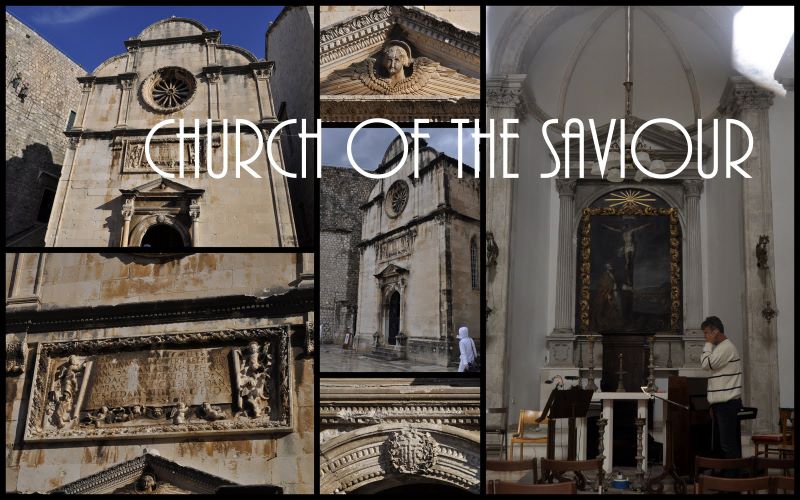
More text and pictures of the exterior of the Church of the Savior are available by clicking here.
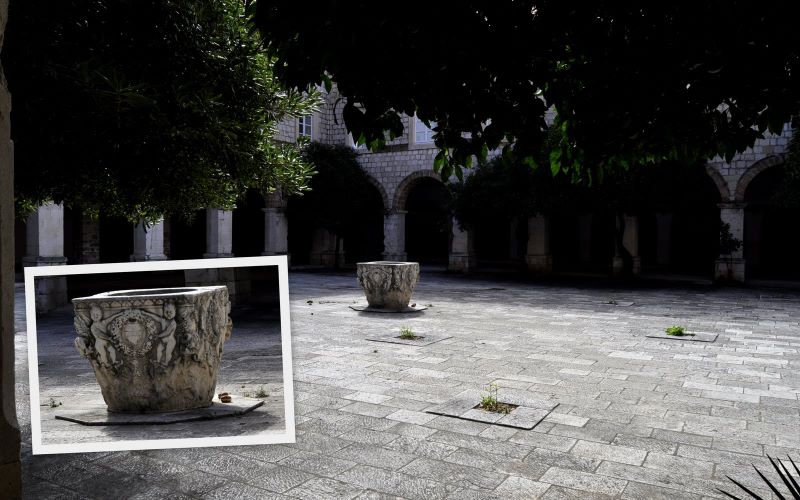
Just south of the Paskoja Milicevica Square with the Onofrio fountain is another monastery -- all but ignored. Once a convent for St. Claire nuns and one of the world's first orphanages for abandoned babies, it was closed by Napoleon's troops while they stayed in the city in the early 1800s (and ended Dubrovnik's republic.) They used it as an ammunition dump and stables. Today the town's tourist office uses this late 13th century complex as popular but pricey tourist restrooms.)
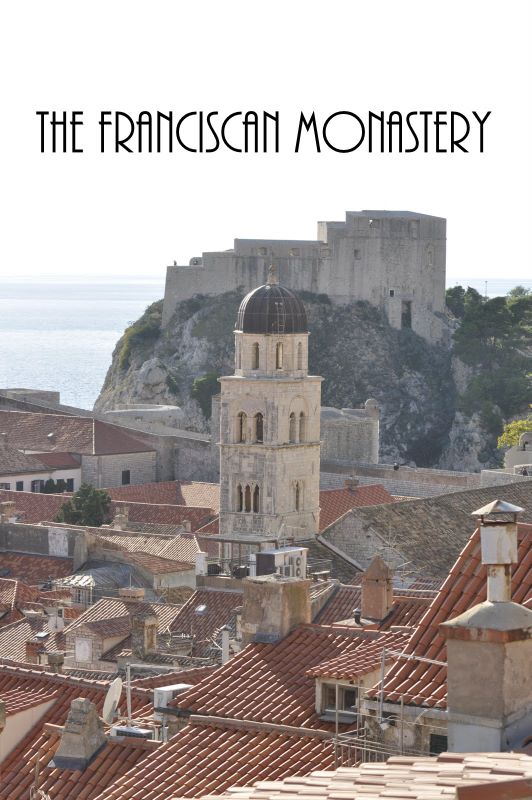 The Franciscan Monastery
The Franciscan Monastery
The Franciscan Monastery (tower above) anchors the west end of Dubrovnik, just inside the Pile gate and extends northward towards the Minceta tower. Here we look west past the Franciscan monastery tower, over the Pile Gate, and towards Ft. Lawrence across the rocky but small west harbor. The monastery was built outside of Dubrovnik but moved inside the walls to protect it in the 14th century.
Dubrovnik's wealth made it the "Athens of Dalmatia" and the religious played a huge part. The three great orders each held edges of a triangle that overlays the old town: Jesuits to the south, Dominicans to the east, and the Franciscans here to the west.
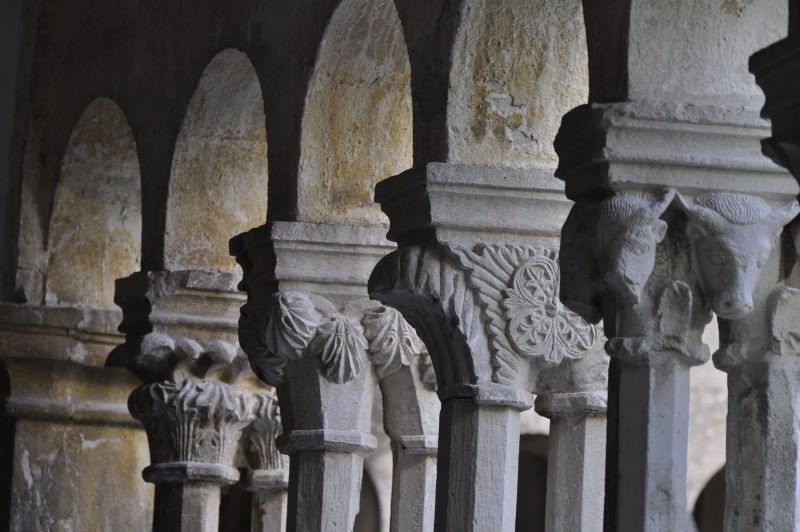
The Franciscan complex envelopes one of the best Romanesque cloisters on the Dalmatian Coast. It's separated from its Gothic garden courtyard by double columns each with unique (and rarely religious) capitals. Here we see perhaps Arab-inspired carved vegetation. Dubrovnik sailors knew Arab architecture well as they sailed the length of the Mediterranean.
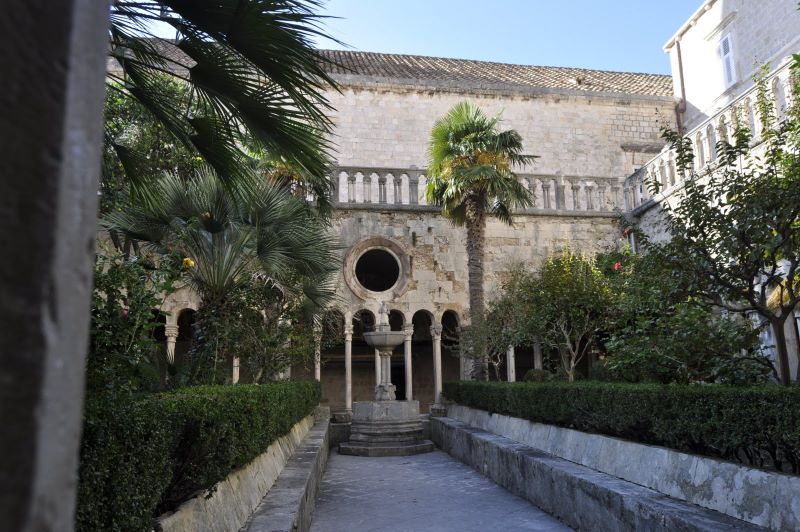
Most cloisters have paths that cross in the center at a fountain. But here Dubrovnik's Franciscan monastery cloister fountain is at the end of a wide path with stone niches on either side. This 1438 fountain was also erected by Onofrio di Giordano della Cava when he brought the waters of River Dubrovnik to the city.

The Franciscan Monastery's double columns frame the oldest existing garden in Dubrovnik, dating from the 14th and 15th centuries. It also contained one of the Dalmatian coast's most important libraries. Even today, its pharmacy -- in continuous operation since 1317 and the third oldest in Europe -- still sells products (but not really pharmaceuticals, just lotions and snake oil to the tourists.)

The monastery cloister somehow survived intact after the devastating 1676 earthquake. A few pieces of the rest of the structure were dusted off and included in the new monastery such as this lovely portal. When built in 1498, it was the most elaborate in Dubrovnik. This Pieta has a bit of Gothic stiffness but the folds in the clothing presage Renaissance carving.
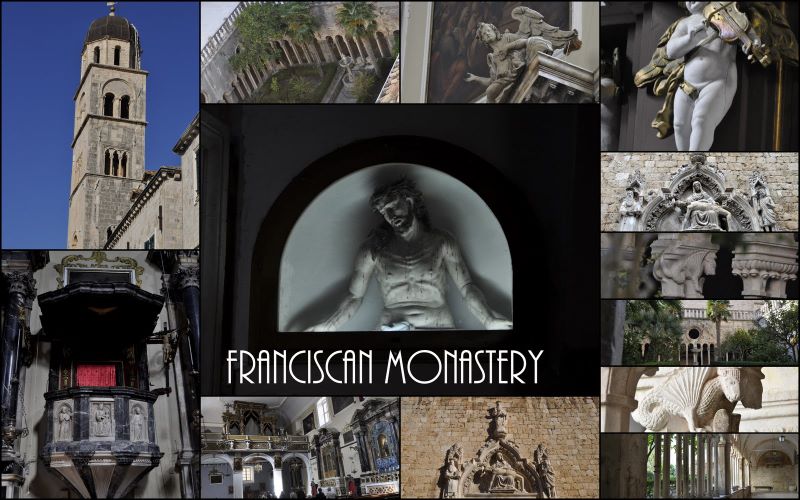
The marble pulpit (lower left) also survived the 1667 earthquake. See it and about 35 more pictures and captions of this structure in our supplemental slideshow by clicking here.

Let's now trek down the Placa (Stradun) towards that distant clock tower that anchors the eastern Loggia or Loza square. The buildings on each side were constructed by order of the Senate after the 1667 earthquake had leveled the heterogeneous collection of Renaissance palaces that the nobility had created. The Senate dictated baroque fronts of approximately the same height -- with retail space on the first floor. Today almost all of the retail is dedicated to the tourist trade -- only 3 stores in all of the old town sell food to the locals.
That earthquake was the beginning of the end of Dubrovnik's golden age. Diplomacy --and the town walls which survived -- kept its enemies at bay as the damaged and vulnerable town rebuilt. About 140 years later the Republic became part of the French empire (for a while.) Pay attention when towers collapse!

Placa (Stradun) Street ends by forming Loggia (Loza) square at its east end. It's the long descender of a backward "L" that then leads south (to the right in this picture) towards the rector's palace and the cathedral. Like Placa street, this square was formed at the end of the 11th century when the marsh was filled in. Behind the clock tower is the old harbor. At left is the Sponza Palace. Just to the right of the clock tower is the Main Guard House rebuilt with Gothic mullioned windows suggesting the earlier building that died in the 1667 earthquake. In front of it at lower right is ...
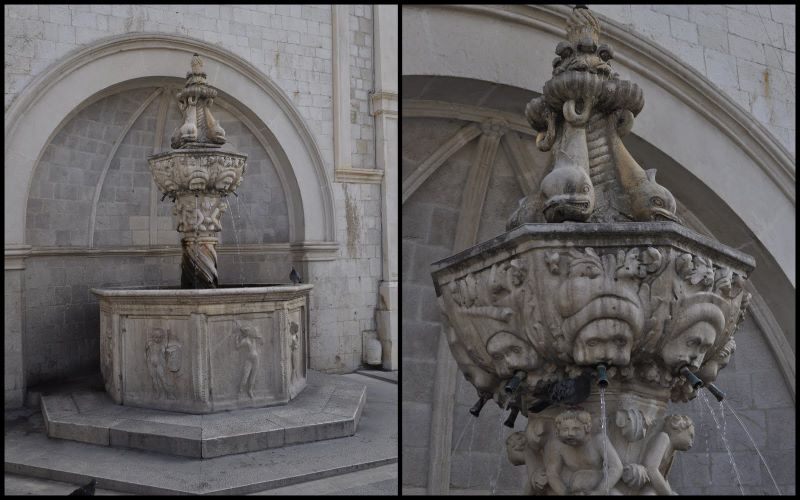
...another Onofrio fountain, much smaller but more elegant than its big brother to the west. Both have distributed water since 1438.
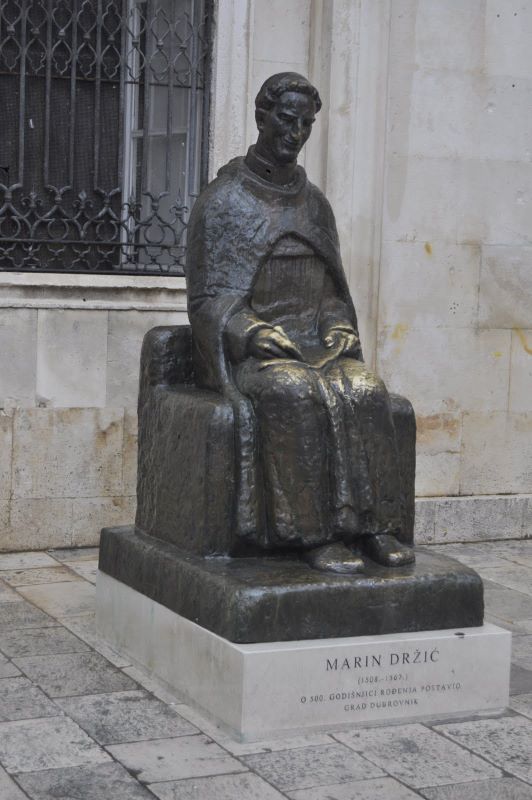
Next to the fountain is this 2008 memorial commemorating the 500th birthday of Croatian Renaissance author and cleric Marin Držić whose comedies played throughout Europe around 1550 (decades before Shakespeare and Moliere elaborated on many of his themes.) He'd probably enjoy the irony of his statue being here in his hometown that prized its independence since he tried to overthrow the republic.
Dubrovnik's theatrical museum is named for this author who wrote 11 plays during the 15 years he lived here -- before moving to Venice and trying to enlist the Medicis in his conspiracy.
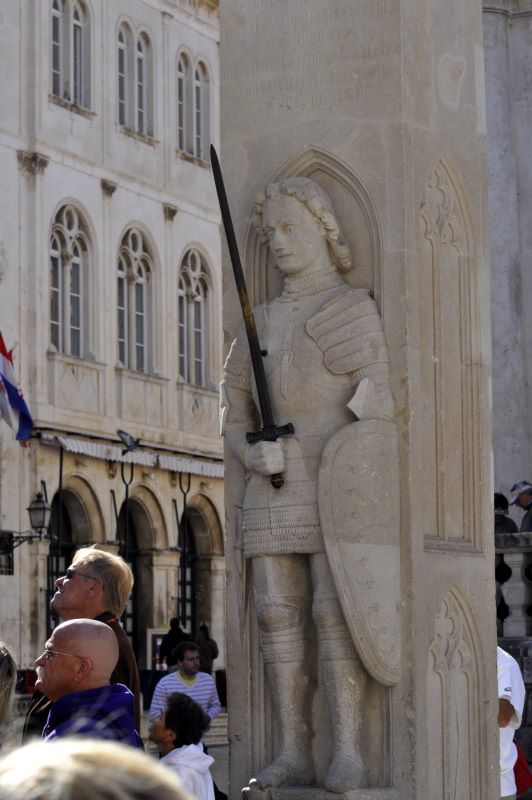
Statues of historic individuals such as Marin Držić's bronze are rare in Dubrovnik. More common are religious or mythical statues such as the Gothic column by Bonino of Milan. It honors Roland, Charlemagne's nephew and epic warrior. From 1418 to the early 1800s, the staff that rose from here flew the flag of the Republic. A storm blew it over in 1825 but it was re-erected 50 years later -- this time facing north.
In medieval times, many trading towns had their own system of measurement. For Dubrovnik, the standard was Roland's forearm, called an "ell" (for elbow as it extended from that joint to the end of his fingers somewhat like the cubit used since Egyptian times.)
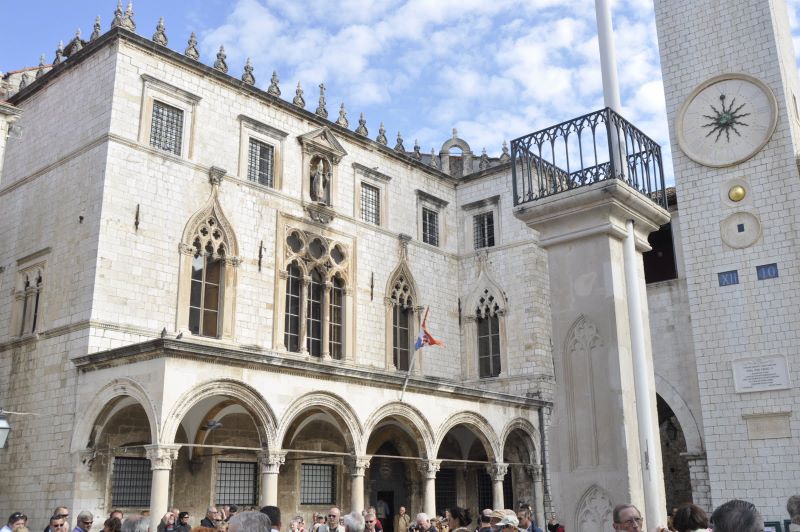
The side of Roland's column is seen at center with the flagpole telescoping upward in front of the clock tower. Note here the Sponza Palace with a Renaissance loggia beneath Gothic mullioned windows. Behind the column we see an arch that led to the port, making this well positioned as the republic's customs house. This Gothic/Renaissance amalgam is typical of the palaces built along the Adriatic in the 15th century; most of those in Dubrovnik were destroyed in the 1667 earthquake. But not the Sponza palace which now suggests how the town looked in its golden age just before the earth moved. (Note the vertical risers between the windows -- they are irons meant to protect from future earthquakes, as is St. Blaise's statue at top center.)
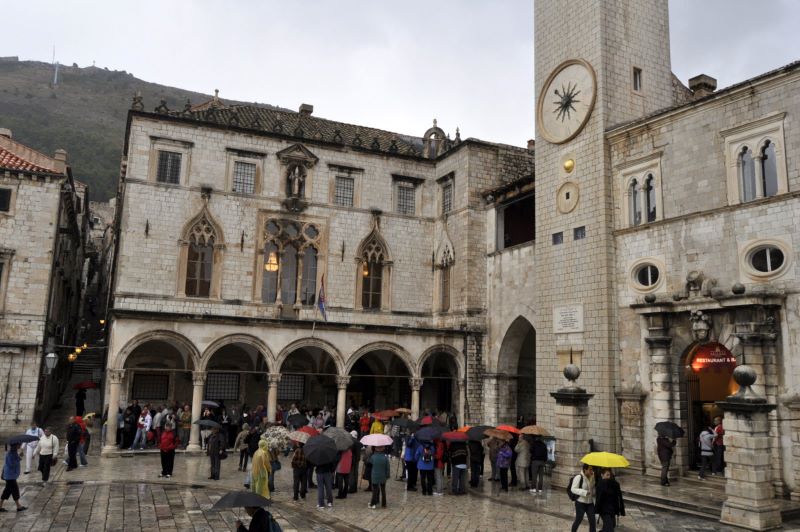
Here's another view showing the arched customs gate to the right of the Sponza palace. To its right is the 100 foot high bell tower built by three local masons in 1444. Earthquakes were not kind to this structure and it was completely rebuilt from the original plans in 1929.
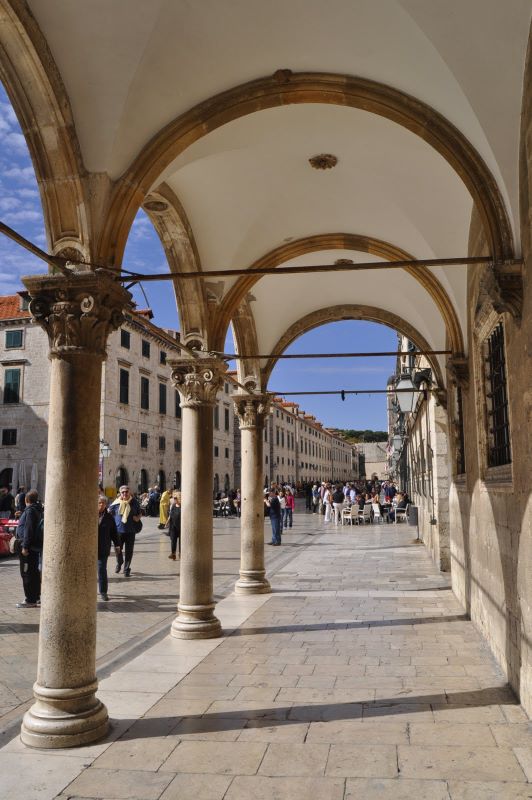
Here we view the Renaissance loggia of the Sponza palace looking west up Placa (Stradun) street. The porch was added in 1516 by the Andrijic brothers. Besides the customs offices and warehouses, this palace also housed Dubrovnik's mint.

Dubrovnik was at the peak of its golden age when the 1667 earthquake leveled most of the town. Then It was at the mercy of its rivals including Venice and the Ottomans. Besides great diplomacy, one reason the republic survived was this building where the affairs of state could still be undertaken.
The Sponza loggia fronts St. Blaise church and the column of Roland at right. Today the palace serves as the archives, one of the most important in the world since in the 13th century Dubrovnik required all public and private legal documents be registered.
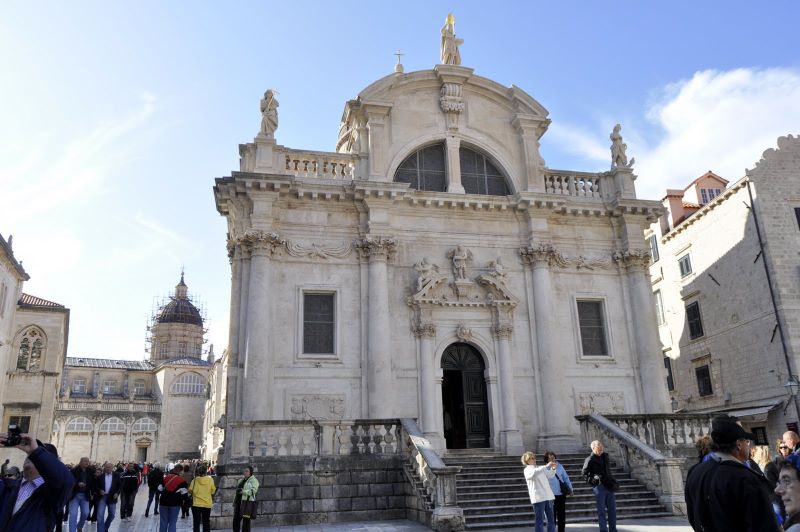
Let's take a closer look at St. Blaise, shown here above its monumental staircase with the scaffold-clad cathedral dome to its left. The 1667 earthquake severely damaged the previous Romanesque structure and a 1706 fire finished the job. The Senate hired a prominent sculptor named Marino Gropelli to model this baroque church on one in his native Venice. (Gropelli was a popular artist and Peter the Great hired him to sculpt some of the Summer Garden statues in St. Petersburg.)

At top St. Blaise rises in front of the church's oblong dome. This structure is essentially a cylinder enclosed in a Renaissance square building.
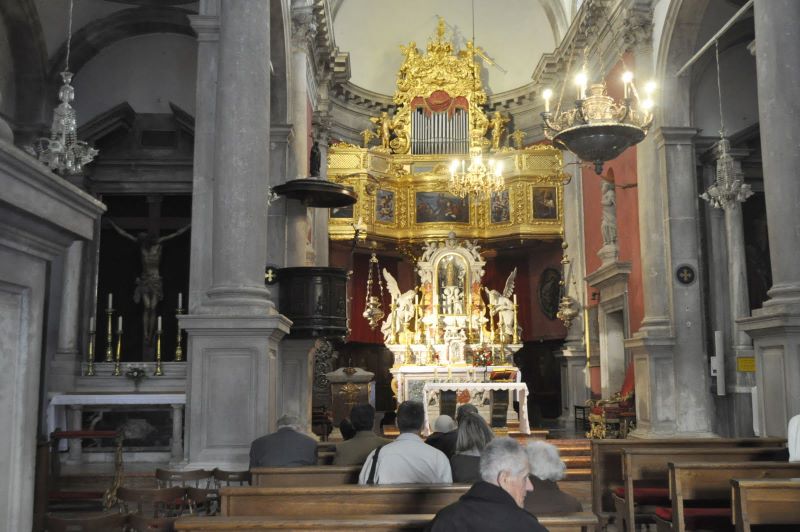
Inside, the main altar glows with typical Baroque elements including the ornate organ with gilt-framed oil paintings...
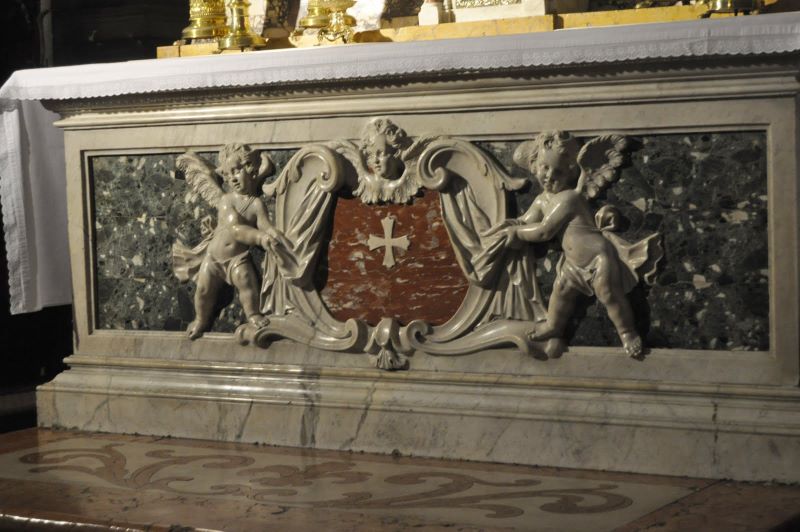
...and this inlaid marble altar with delicate facial features and drapery folds!
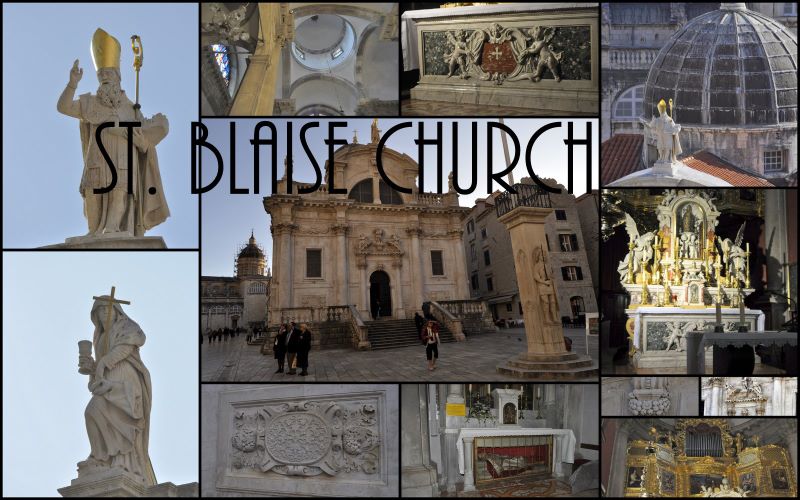
We have more explanation and pictures of St. Blaise Church at our supplemental picture site (click here to view).
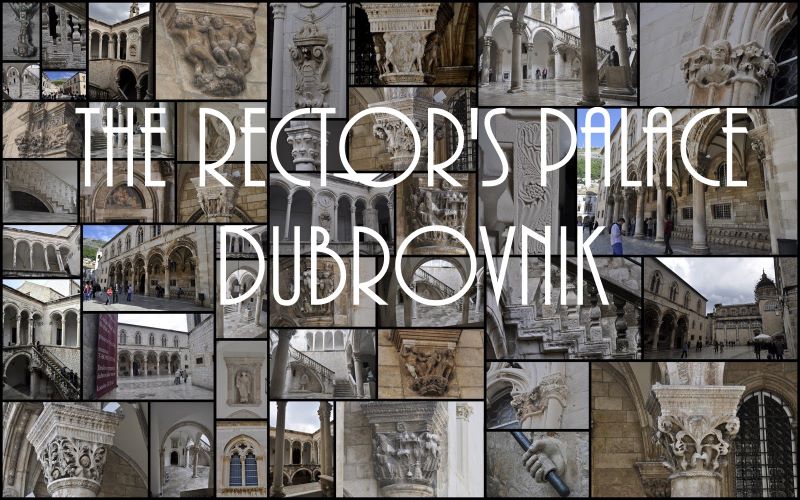
Let's look at one of the most impressive civil buildings along the Dalmatian coast -- Dubrovnik's Rector's Palace. The Senate (50-60 people who ran Dubrovnik) met here -- and forced their "leader" to live here without leaving the building during his term. (This wasn't all that bad since to keep anyone from grabbing power, the city restricted rectors to a 30 day term. They could serve many times as terms appeared to be unlimited, just not very long. To remain free, Dubrovnik played its external enemies off against each other and structured its internal politics to keep tyrants from emerging.)

This somewhat warped picture shows the lower floor with its Renaissance loggia supporting beautiful Gothic windows above. The wide areas on each side of the loggia were once the base for towers -- both of which were damaged when the place suffered a fire and explosion 11 years after it was built -- to replace an earlier fortress destroyed by an ammunition explosion. (Keep in mind that the harbor is just behind this site).
Two major earthquakes also took their toll. The rebuilding of this once-Gothic building cleverly harmonizes Renaissance and Baroque elements as well.Each night the keys to the locked gates of Dubrovnik were brought here and turned over to the Rector in a pompous ceremony.
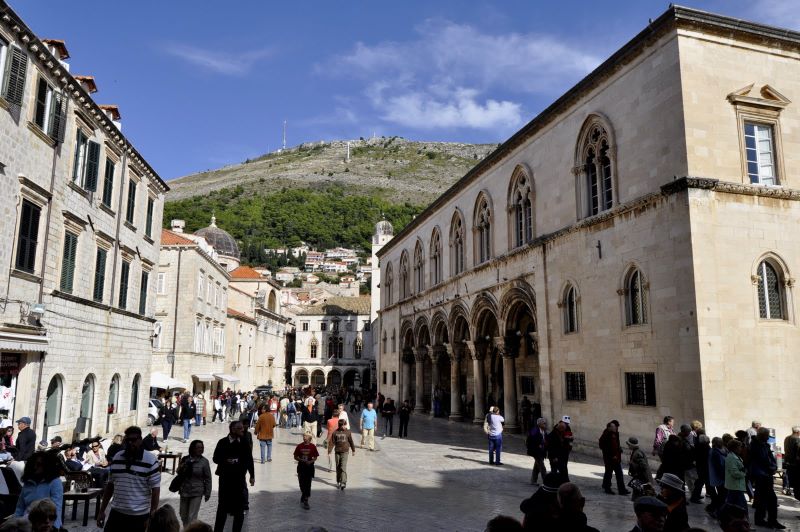
Near the south end of the wide street anchored at the north by the Sponza Palace, stands the Rector's Palace with its own loggia). Looking up, we see Mount Srdj, Dubrovnik's protector from the harsh north winds (the bura).
Mount Srdj shows traces of the fort the French built when Napoleon's guys overstayed their welcome. In 1991, the Serbs shelled from up there and destroyed the cable car that once took tourists to its 1300 foot summit.
Events have conspired to destroy the Palace at right since Onofrio's original design (yes, the fountain guy). Subsequent rebuilds have changed its exterior dramatically. The boxy corners originally had towers that disappeared in a 1463 explosion. The facade then received its upper Gothic windows over a Renaissance loggia.
The south end (we see a bit of it at the right) was restored after the 1520 earthquake in the Baroque style. Severely damaged, somehow this structure survived the 1667 earthquake that leveled most buildings within Dubrovnik's walls.
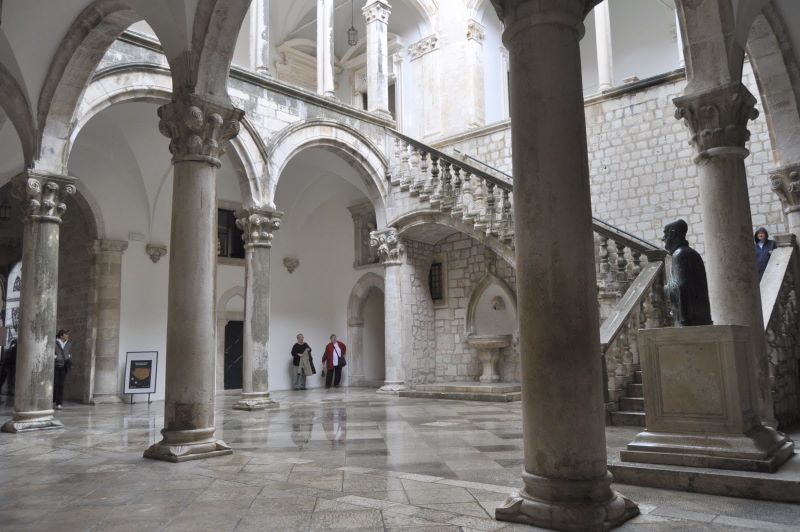
Inside, the Rector's Palace features a Renaissance atrium used as 1 of 30 venues for the annual summertime Dubrovnik Festival which features the performing arts. This festival is no mere sop to the tourists; Dubrovnik geographic position created trade wealth. Wealth and access made this town for centuries the heart of southern Slav culture. (In Croatian, "Yugoslavia" literally means the land of the south Slavs.)
Eventually Venice conquered most of the Dalmatian coast except for the Dubrovnik republic. They actively discouraged education and the arts: they needed the coastal population for soldiers and galley slaves. (After seeing Venice twice, I don't think I would argue that they needed more artists!) This left independent Dubrovnik pretty much unchallenged as the cultural heart of Croatia.The baroque staircase was added after the 1520 earthquake and includes...
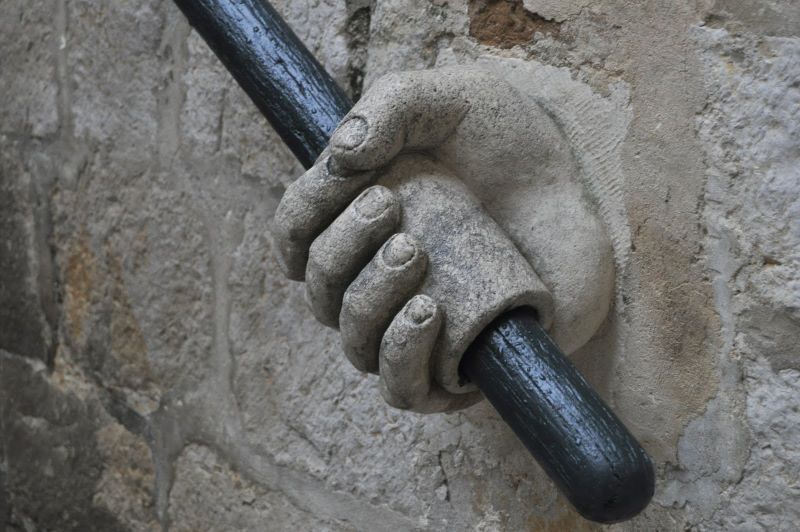
...a "hand" rail.If you want to see more of the Rector's Palace, try our dedicated slide show by clicking here.
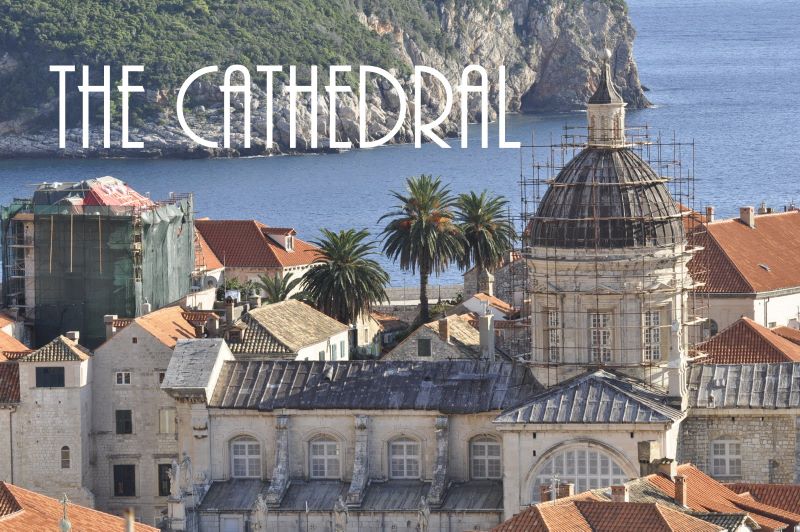
The Cathedral rises across from the Rector's Palace. Like St. Blaise church, it's an 18th century rebuild of its predecessor destroyed by the 1667 earthquake. This angle shows its Latin cross shape with three naves underneath a crossing dome.
The Romanesque 12-14th century cathedral this replaced also had a cupola -- but that one was richly decorated with statues. Supposedly Richard the Lion Heart had been shipwrecked on the island in the background in 1192 after the 3rd Crusade and had donated money for the earlier cathedral.
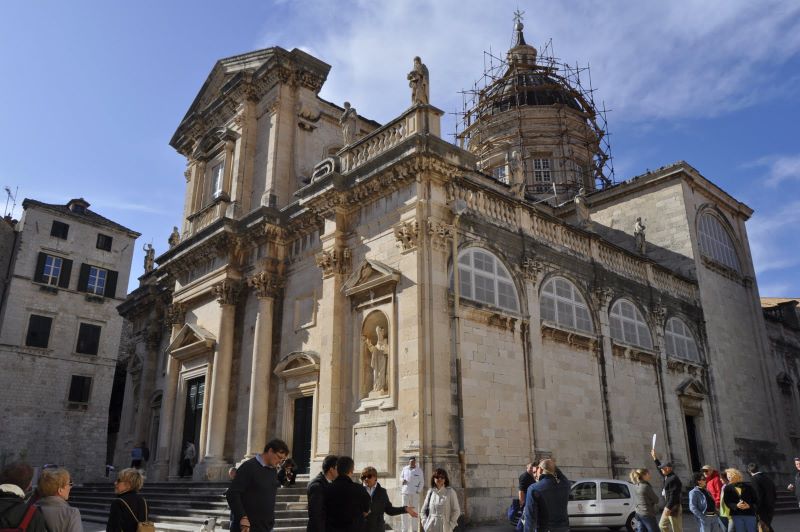
Restoration work in 1981 uncovered the foundations of what appeared to be a 7th century cathedral -- some of the first indications that the city was thriving that early. After the 1667 earthquake, an influential Dubrovnik cleric had an important job in Rome -- and convinced the Senate to use the famous Roman architect Andrea Buffalini to build the new cathedral in Roman Baroque style.
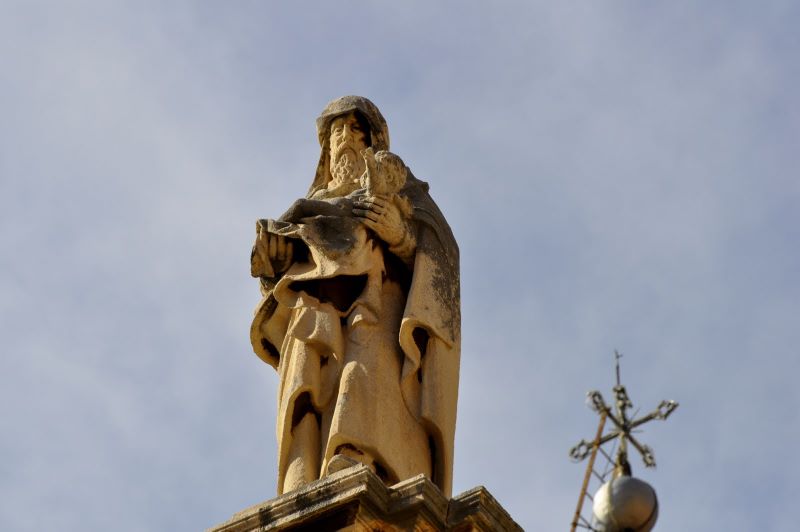
Buffalini's baroque cathedral, dedicated to the Assumption of Mary, has not been as well restored as St. Blaise up the block. Its roof statues need some refurbishment.

The four Corinthian capitals that bring a bit of Baroque frosting to the Cathedral's portal show a bit of neglect -- but scaffolding around the dome suggests that Dubrovnik will eventually get around to restoring the rest of the cathedral's exterior. The original work started in 1671 and completed in 1713.

Inside Buffalini designed a 3-nave baroque space defined by soaring columns beneath the cupola. From high above, baroque windows bathe the sparse walls with light.

The side altars are resplendent in marble such as this one to the Czech John of Nepomuk, martyred by not-so-good King Wenceslaus who wanted this priest to break the seal of the confessional. (Another version has him on the wrong side of politics, and a third makes him a figment of the Jesuits' imagination.) He was drowned shortly after this church opened.
Whatever his confused history, John's altar is a masterpiece of violet marble exploding in northern Baroque style.
Nearby is the entrance to the Cathedral treasury, the richest on the Dalmatian coast. So rich that it took three different keys -- held by both church and state representatives -- to open it.
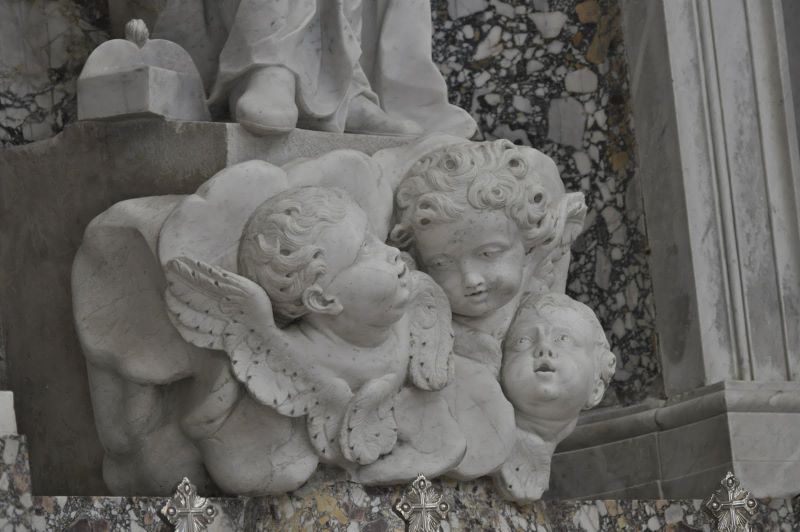
These cherubs watch Jon of Nepomuk's feet. Even though he died by forced drowning, he is now the patron saint of floods (but probably not of waterboarders in undisclosed locations.)
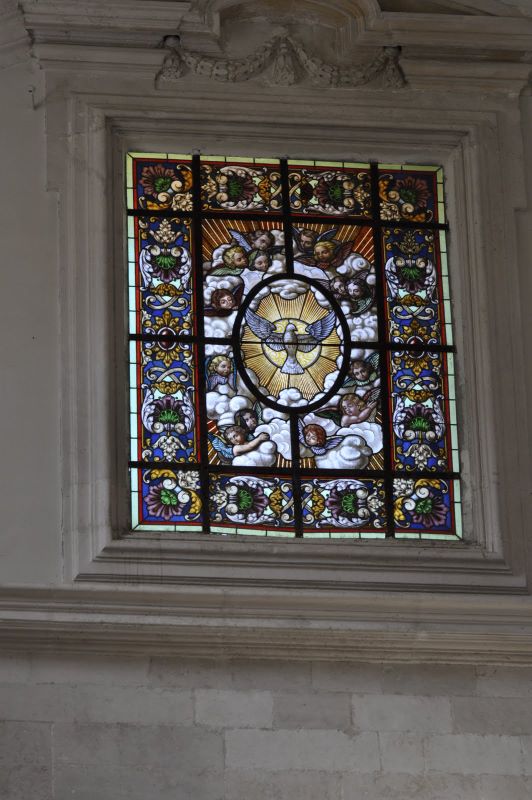
Most of the stain glass found here has a late 19th century feel to it. Given extent of the Serb shelling in 1991, it may be even newer.
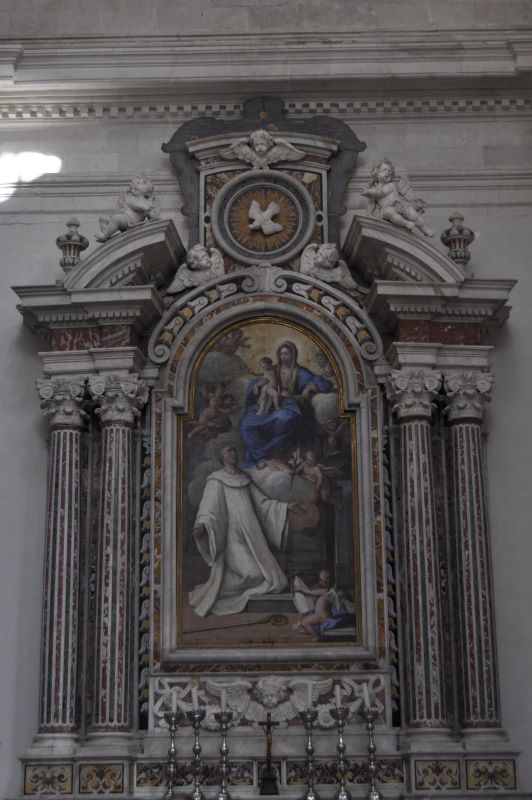
Here's another side altar with inlaid Corinthian columns framing this oil of St. Bernard. It's the work of Carlo degli Frangi.

Just west of the cathedral, we encountered an active market square named for Dubrovnik's most famous poet, Ivan Gundulić. THE figure of the Golden Age of Dubrovnik literature, he wrote dramas and both epic and lyric poetry. Bono recently recited some of his lyrics extolling freedom.By day this is a market; at night during the summer, it is large performance space for the Dubrovnik Festival. Of course, this square would have an Onofrio fountain but also...

...a more modern statue of Ivan Gundulić, in this case a bronze by Ivan Rendić, who championed Croatian nationalism and placed bronzes of its heroes in many public squares. The panels below Gundulić's statue depict scenes from his epic "Osmun."
When this statue was unveiled in 1893 (Gundulić's 300th birthday), it exacerbated nationalistic rivalries between Croats and Serbs -- about 100 years before the Serbs would return to Dubrovnik with their mortars.
Gundulić was from a long line of Dubrovnik nobility: both his father and son were rectors many times over. (Remember, rectors serve for only one month.) Gundulić himself would have been rector but he died at age 50 -- the youngest age that a man could serve. Remembered as a writer of Croatian Baroque epic poems rather than as a politician, Gundulić was a champion of the counter-reformation and, no suprise, was trained by those premier counter-reformationist Jesuits whose church we see raising its cross high above Gundulić's statue in the distance.
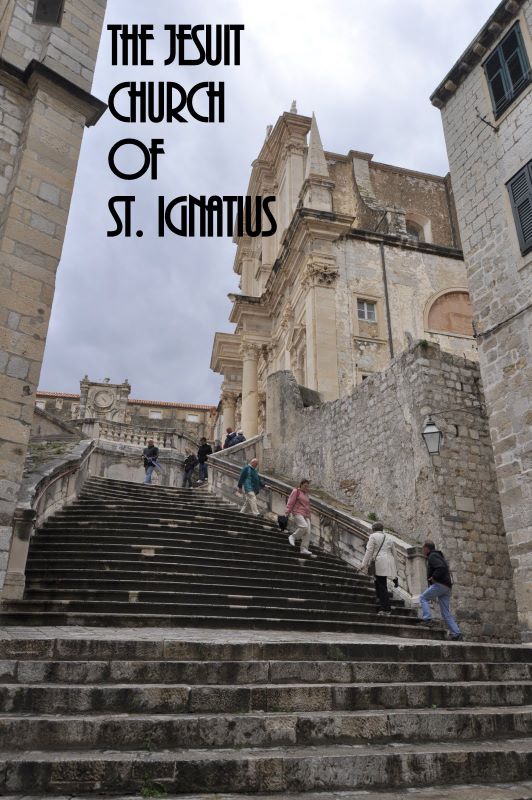
The Jesuit church is on a steep slope of what was once the island protecting the Roman colony of Ragusa. This monumental stairs built in 1738 by Pietro Passalacqua leads up to it. Passalacqua later worked on several basilica facades in Rome. While these steps could use a bit of spiffying up, they were extensively repaired after being damaged in 1991 by Serb shelling.
Dubrovnik likes tourists to believe that these resemble the Spanish Steps in Rome -- but that's a huge stretch.
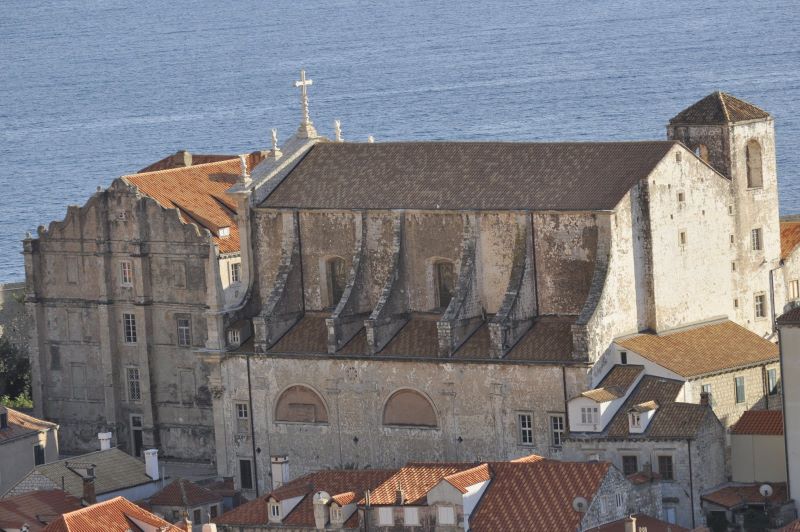
This view taken from the city walls shows a trace of the thin baroque facade at center -- and the much simpler buttressesed nave and side chapels of the Jesuit church. To the left is the old university, Collegium Ragusinum.The Reformation was virtually unknown in Catholic Dubrovnik and so there was little need for this great counter-Reformation order to combat it. But when Dubrovnik quelled a rebellion (over taxation) on the nearby island of Levano in 1602, 2 priests were murdered and Pope Clement VIII imposed a ban which he lifted 2 years later -- on condition that Dubrovnik bring in the Jesuits.
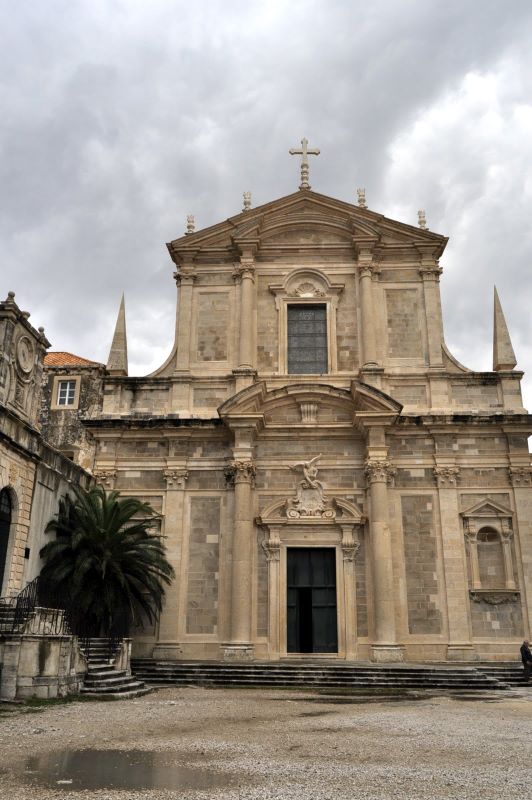
The facade is similar to another Roman structure with which this Church of St. Ignatius shares its name. During the 17th and 18th centuries, many members of the order were architects and deliberately shared plans to create a Jesuit style whose intent was to glorify the Catholic Church (as opposed to the Spartan structures of some Protestant religions gaining footholds in parts of Europe.)
Look closely at the foreground. Although this is one of town's major squares, it is not paved and drainage of the October rains is somewhat challenged. In Venice, this would be a square built over a cistern that would hold the rainwater. Onofrio's aqueducts make such drainage unnecessary in Dubrovnik. Instead, it gets mountain-spring water -- and puddles after the rain.
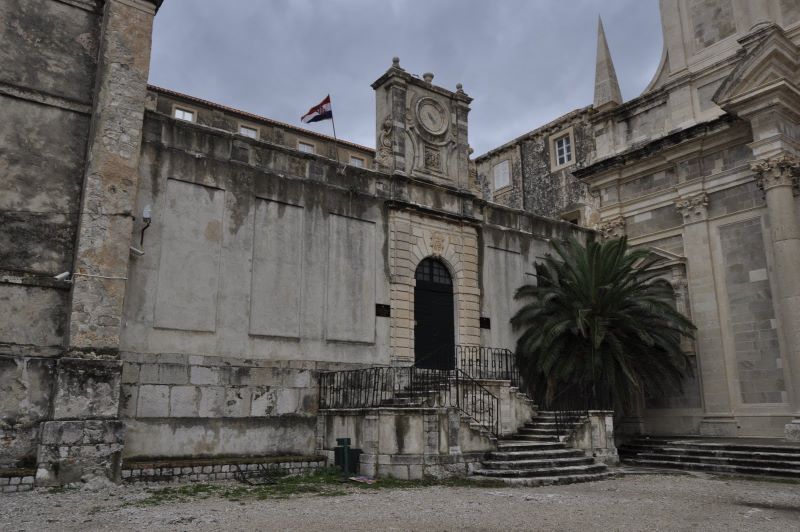
Built perpendicular to the church, the old Collegium Ragusinum educated Dubrovnik's elite. After the Jesuit order was disbanded in 1773, Napoleon's troops used the place as a hospital and it had several other lives until 1941 when the local bishop made it into a high school and a seminary. Students here take four years of Latin and classical Greek. For some of you readers, that would be deja vu (pardon the French, s'il vous plaît.)
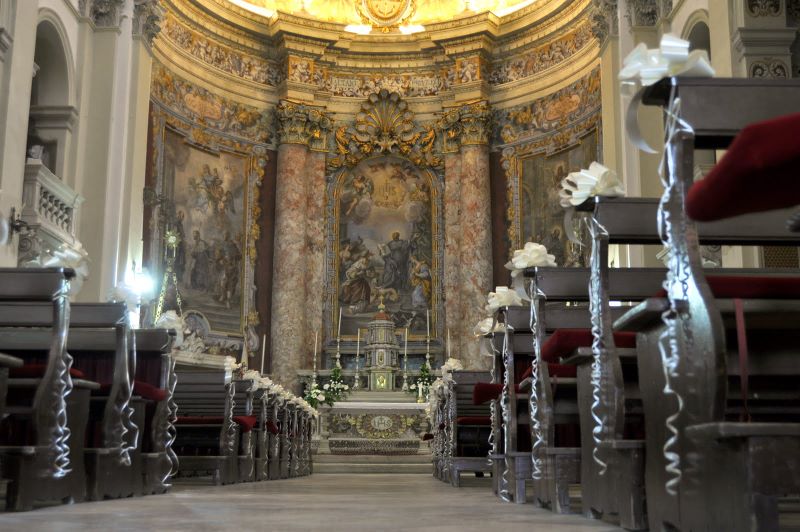
Dubrovnik's Church of St. Ignatius is the design of the Jesuit architect and baroque painter Andrea Pozzo -- sort of. It was clearly inspired by its namesake in Rome. At the main altar, baroque multi-colored marble columns and ornate frames highlight frescoes by Gaetano Garcia showing scenes from the life of the Jesuit founder, Ignatius of Loyola. Above...
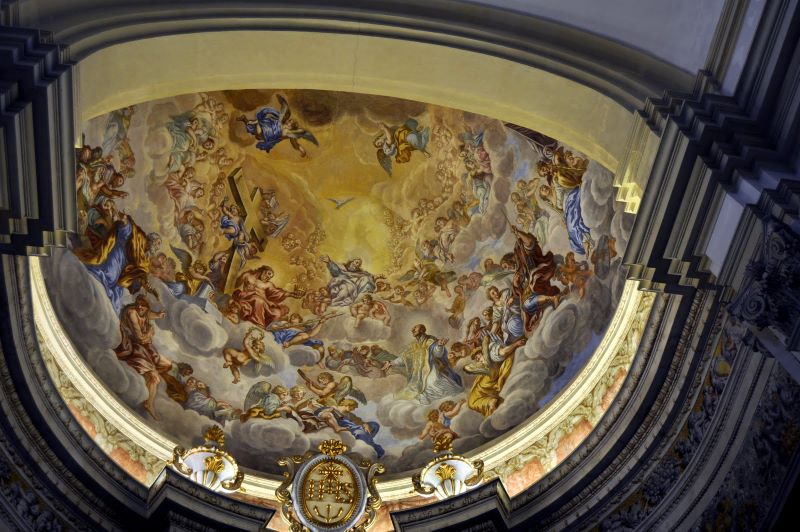
...the frescoed apse half-dome over the IHS symbol of the Jesuits, Ignatius enters the pantheon of the saints. -- and Christ offers him a crown. Perhaps the greatest baroque ceiling painter, the Jesuit lay brother Pozzo as architect here tasked the Sicilian Gaetano Garcia with creating this this fresco over the sanctuary. In imitation of Pozzo's masterpiece in Rome, Garcia depicts the Apotheosis of St. Ignatius (shown here in mass attire at about 5 o'clock position) as he looks up at the trinity with Christ holding out a crown for him. This may be the most impressive painting in Dubrovnik.

We've posted more pictures of what may be the largest and most elaborate church in town -- along with some comparison photos of St. Ignatius Church in Rome and the Spanish Steps. See them by clicking here.
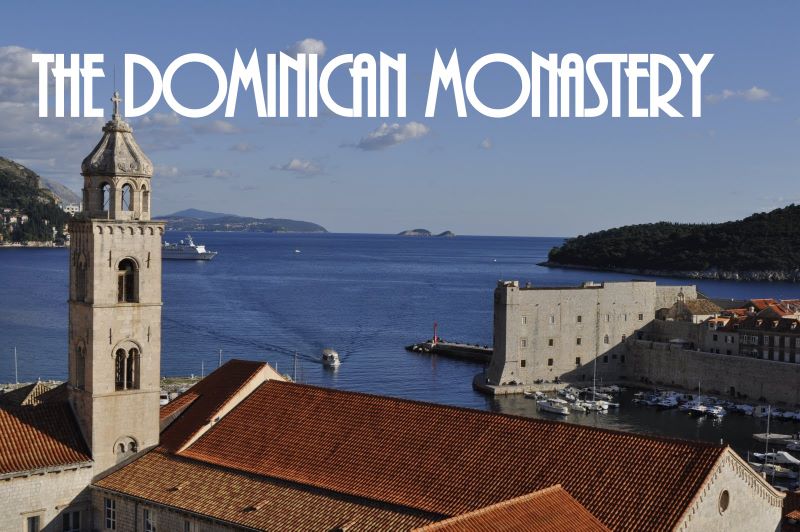
Let's now look at the monastery of the third order hosted by Dubrovnik at its east end where we see their bell tower watching over the harbor. The tower was not completed until the 18th century even though the Dominicans arrived in 1225. Much of the rest of their complex was completed in the 14th century..

Established at a key point on the eastern defenses of the town, parts of the Dominican complex served as prosaic town walls. Eventually the walls were extended around the monastery which allowed Bonino of Milan (remember Roland's statue?) to add this now beautifully restored Gothic arch to the southern entrance to the church in 1419. The half-round stairs solve the problem of the church being built on a hillside with its worship space high above the street level. It unfolds elegantly from this simple small ashlar wall.
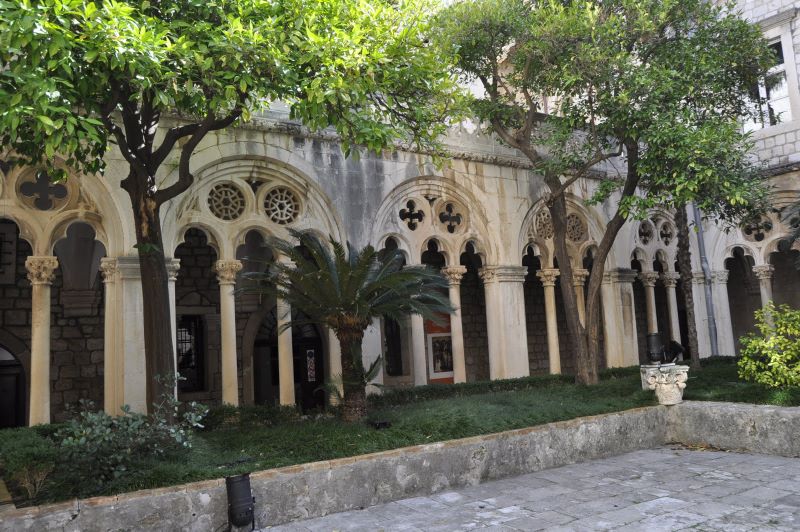
At the west end of the old city, the cloister of the Franciscan monastery is near the gate where most tourists enter. Consequently its cloister is filled with noisy tour guides stewarding their charges like so many cameraed cows. By contrast, the Dominican cloister at this east end is nearly empty. The beauty of these arches with their trifora openings is enhanced by the quiet.
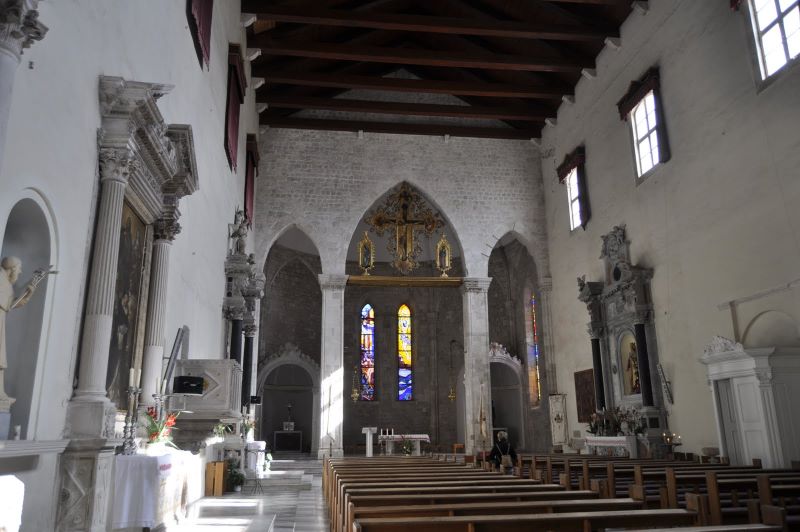
Inside, we have a great hall church -- a large worship space designed to bring in huge numbers of the faithful to hear the sermon. In fact, this is one of the largest Gothic buildings on the eastern Adriatic coast. The box of the nave leads to a 3-arched sanctuary that suggests a Gothic cathedral with its nave and side aisles. Note the simplicity of the wall.
If you'd like to see more descriptive text and pictures of this monastery, click here.

Let's now explore some of the Dubrovnik area. The old city (marked with an "A" on this Google map) holds about 1500 of the 50,000 inhabitants of greater Dubrovnik. Its now larger harbor is shown here at upper left and the road that crosses the Ombria (Trebišnjica) River at about 10 o'clock position does so ...
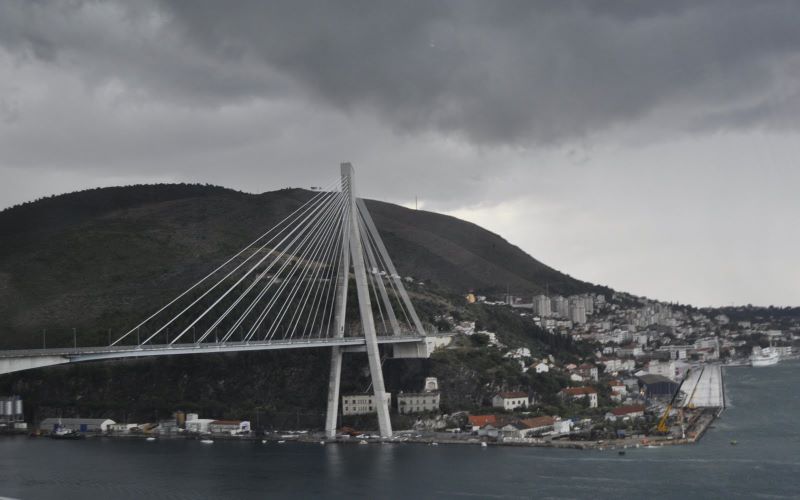
... on the elegant Franjo Tudman Bridge. Completed in 2002, this asymmetric single pylon stay cable bridge is over 1599 feet long and was designed by the Civil Engineering Department of the University of Zagreb. Winds are quite strong here: computer simulations were run and models of the bridge were tested in wind tunnels. This paid off when winter storms sent 70 mph winds vibrated the 19 cable pairs in 2005 and 2006. But snow stuck to the cables changing the predicted vibrations; shortly thereafter new technology was developed to dampen the effect of snow and wind by a factor of 10, making this bridge -- already one of the longest stay bridges in Europe -- also a pioneer.
To the right is Dubrovnik's modern port also called the Port of Gruž. Here the heavy freight is off-loaded and most of the 700 passenger ship landings take place each year.
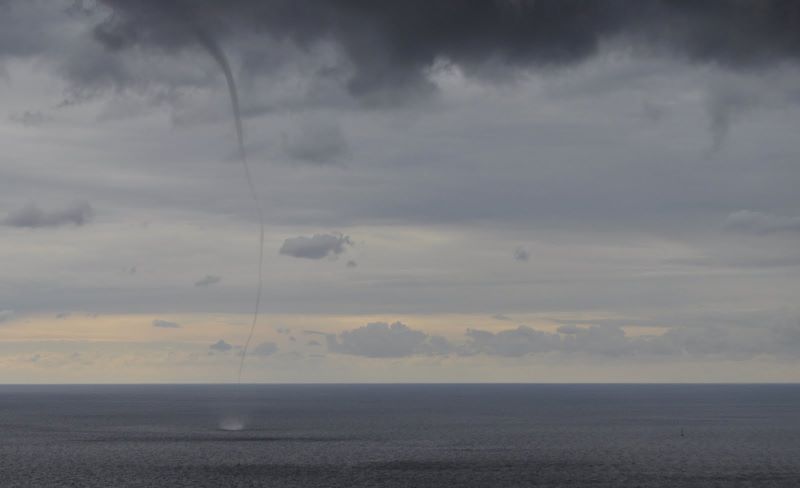
Considerably less low tech was this tornado we saw roiling the Adriatic just north of the bridge. This is why you test your designs in wind tunnels! Croatia has over 1000 islands in the Adriatic that shelter much of its towns like Dubrovnik from the south winds. Here we have open sea.

Here's a typical view of the Dalmatian coast a few miles north of Dubrovnik: lots of rocky coves reaching up to mountains steeply descending to the clear sea. Because this area was firmly in Dubrovnik's control and near the city, it became the site for the nobles to build their villas with gardens copied after the Italians. As you can see, this terrain is not an ideal place for Italian Renaissance gardens whose symmetrical boxwood hedge layouts eat up a lots of flat lawns.The most impressive and best preserved of these gardens is near here...
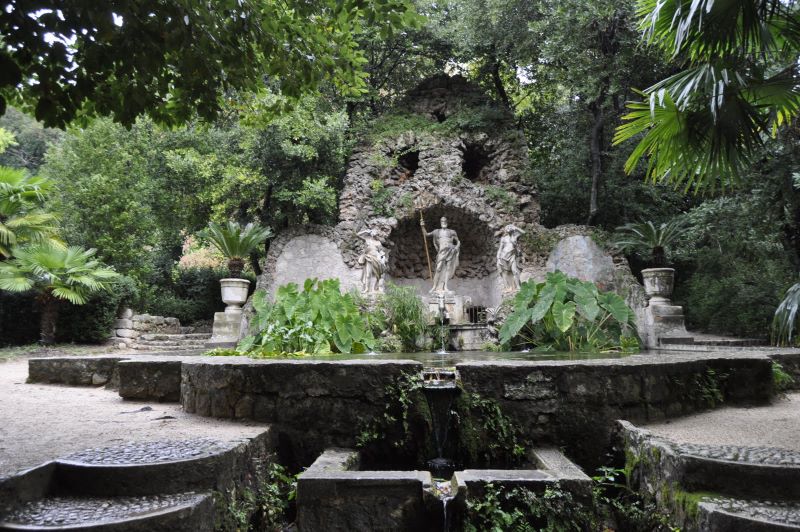
... It's the old Renaissance estate at Trsteno, a village up the coast about 12 miles from Dubrovnik. At its center is this fountain with statues, including that of Neptune, god of the sea which he can just about see from this vantage point. Originally, the aqueduct ended in a cave with statues.
The above redo with Neptune, 2 nymphs, and a dolphin is from the 18th century. Statues in Dubrovnik gardens were integrated with their fountains and never stood alone. Such lavish fountains were also rare; most water came from the sea as fresh water was quite scarce (and forbidden by law to be used for garden ponds.)

What makes this garden work even today is this aqueduct with its 14 arches leading to that Renaissance fountain.
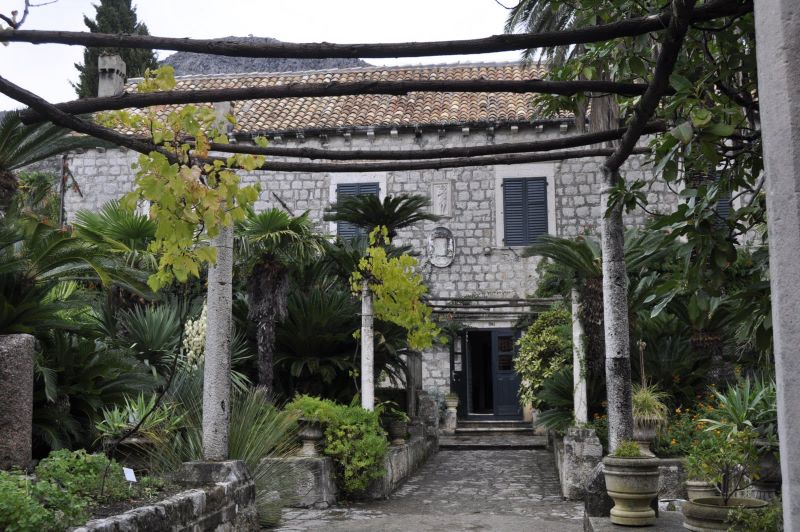
Unlike the Renaissance gardens of Italy, Dubrovnik gardens often contain pergolas for vines, often leading to (and extending) the house. Typically their supporting columns would be placed on low walls which define the garden in the absence of boxwood shrubs. This use of stone walls evolved from the monastery gardens of the middle ages. Pergolas themselves are much older and date back to at least ancient Egypt.

To learn more about the Italian gardens of Dubrovnik and see many more pictures of this site, click here.
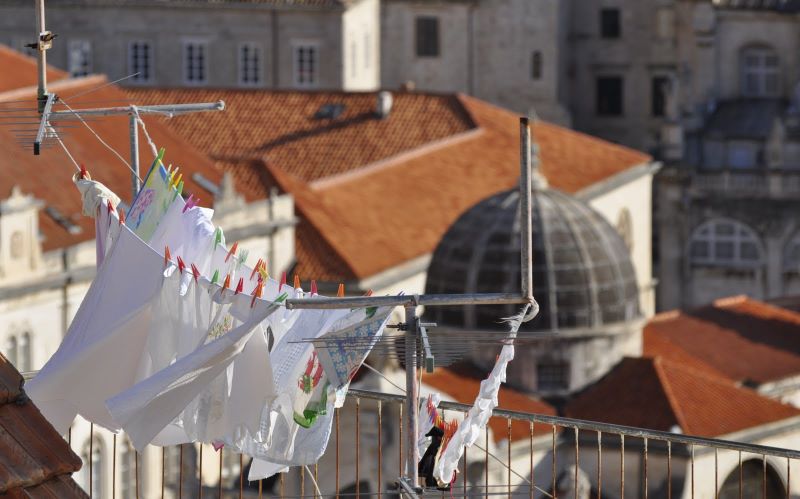
Back to the old town for a parting thought. Here TV antennas and clothesline suggest that people still live here: in fact, only about 1500 still do. Most apartments are being sold to part-timers. Apartment costs are rising and are now above $500/square foot -- about half of Manhattan's but high enough to make the native population threatened. As we would see on this trip, this would be even more the case at the Adriatic's biggest jewel, Venice.
|
Please join us in the following slide show to give Dubrovnik the viewing it deserves by clicking here. |
Geek and Legal StuffPlease allow JavaScript to enable word definitions. This page has been tested in Internet Explorer 8.0, Firefox 3.0, and Google Chrome 1.0. Created on January 10, 2010 |
 |